Relationship between Age, Gender, and Will to Quit Smoking
VerifiedAdded on 2023/01/10
|23
|4283
|85
AI Summary
This essay explores the relationship between an individual's age and gender and their will to quit smoking. It discusses barriers to quitting smoking and ways to overcome them.
Contribute Materials
Your contribution can guide someone’s learning journey. Share your
documents today.

CW3
Secure Best Marks with AI Grader
Need help grading? Try our AI Grader for instant feedback on your assignments.
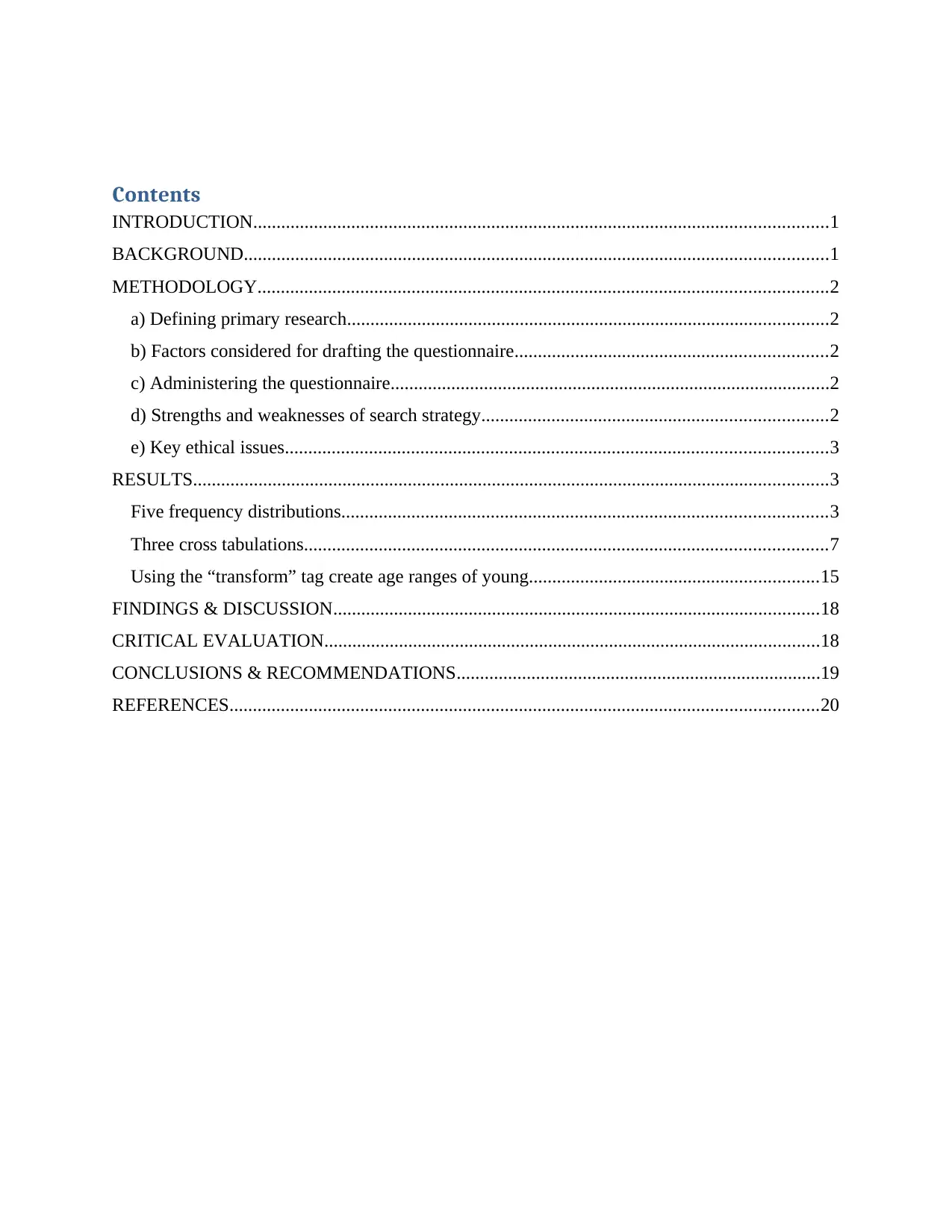
Contents
INTRODUCTION...........................................................................................................................1
BACKGROUND.............................................................................................................................1
METHODOLOGY..........................................................................................................................2
a) Defining primary research.......................................................................................................2
b) Factors considered for drafting the questionnaire...................................................................2
c) Administering the questionnaire..............................................................................................2
d) Strengths and weaknesses of search strategy..........................................................................2
e) Key ethical issues....................................................................................................................3
RESULTS........................................................................................................................................3
Five frequency distributions........................................................................................................3
Three cross tabulations................................................................................................................7
Using the “transform” tag create age ranges of young..............................................................15
FINDINGS & DISCUSSION........................................................................................................18
CRITICAL EVALUATION..........................................................................................................18
CONCLUSIONS & RECOMMENDATIONS..............................................................................19
REFERENCES..............................................................................................................................20
INTRODUCTION...........................................................................................................................1
BACKGROUND.............................................................................................................................1
METHODOLOGY..........................................................................................................................2
a) Defining primary research.......................................................................................................2
b) Factors considered for drafting the questionnaire...................................................................2
c) Administering the questionnaire..............................................................................................2
d) Strengths and weaknesses of search strategy..........................................................................2
e) Key ethical issues....................................................................................................................3
RESULTS........................................................................................................................................3
Five frequency distributions........................................................................................................3
Three cross tabulations................................................................................................................7
Using the “transform” tag create age ranges of young..............................................................15
FINDINGS & DISCUSSION........................................................................................................18
CRITICAL EVALUATION..........................................................................................................18
CONCLUSIONS & RECOMMENDATIONS..............................................................................19
REFERENCES..............................................................................................................................20

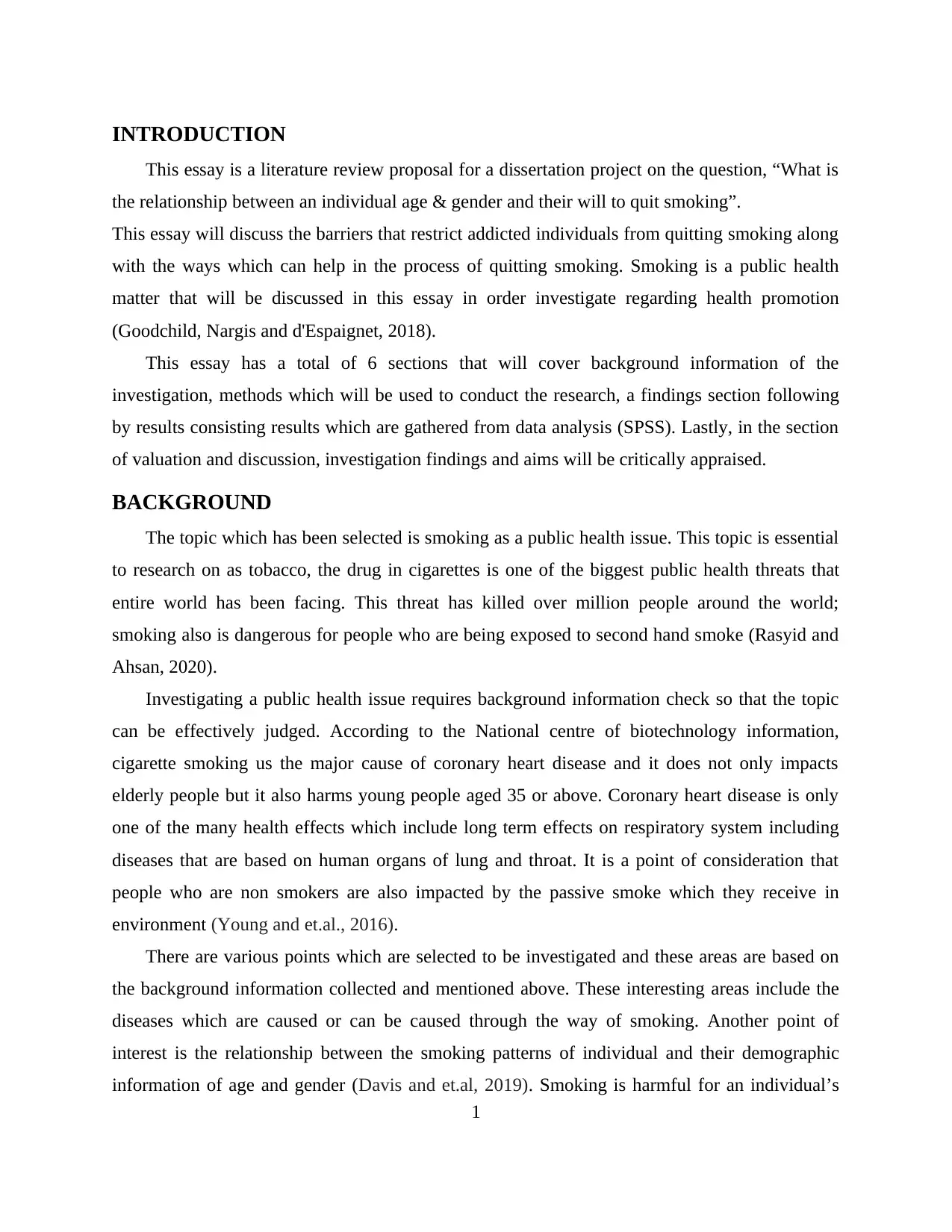
INTRODUCTION
This essay is a literature review proposal for a dissertation project on the question, “What is
the relationship between an individual age & gender and their will to quit smoking”.
This essay will discuss the barriers that restrict addicted individuals from quitting smoking along
with the ways which can help in the process of quitting smoking. Smoking is a public health
matter that will be discussed in this essay in order investigate regarding health promotion
(Goodchild, Nargis and d'Espaignet, 2018).
This essay has a total of 6 sections that will cover background information of the
investigation, methods which will be used to conduct the research, a findings section following
by results consisting results which are gathered from data analysis (SPSS). Lastly, in the section
of valuation and discussion, investigation findings and aims will be critically appraised.
BACKGROUND
The topic which has been selected is smoking as a public health issue. This topic is essential
to research on as tobacco, the drug in cigarettes is one of the biggest public health threats that
entire world has been facing. This threat has killed over million people around the world;
smoking also is dangerous for people who are being exposed to second hand smoke (Rasyid and
Ahsan, 2020).
Investigating a public health issue requires background information check so that the topic
can be effectively judged. According to the National centre of biotechnology information,
cigarette smoking us the major cause of coronary heart disease and it does not only impacts
elderly people but it also harms young people aged 35 or above. Coronary heart disease is only
one of the many health effects which include long term effects on respiratory system including
diseases that are based on human organs of lung and throat. It is a point of consideration that
people who are non smokers are also impacted by the passive smoke which they receive in
environment (Young and et.al., 2016).
There are various points which are selected to be investigated and these areas are based on
the background information collected and mentioned above. These interesting areas include the
diseases which are caused or can be caused through the way of smoking. Another point of
interest is the relationship between the smoking patterns of individual and their demographic
information of age and gender (Davis and et.al, 2019). Smoking is harmful for an individual’s
1
This essay is a literature review proposal for a dissertation project on the question, “What is
the relationship between an individual age & gender and their will to quit smoking”.
This essay will discuss the barriers that restrict addicted individuals from quitting smoking along
with the ways which can help in the process of quitting smoking. Smoking is a public health
matter that will be discussed in this essay in order investigate regarding health promotion
(Goodchild, Nargis and d'Espaignet, 2018).
This essay has a total of 6 sections that will cover background information of the
investigation, methods which will be used to conduct the research, a findings section following
by results consisting results which are gathered from data analysis (SPSS). Lastly, in the section
of valuation and discussion, investigation findings and aims will be critically appraised.
BACKGROUND
The topic which has been selected is smoking as a public health issue. This topic is essential
to research on as tobacco, the drug in cigarettes is one of the biggest public health threats that
entire world has been facing. This threat has killed over million people around the world;
smoking also is dangerous for people who are being exposed to second hand smoke (Rasyid and
Ahsan, 2020).
Investigating a public health issue requires background information check so that the topic
can be effectively judged. According to the National centre of biotechnology information,
cigarette smoking us the major cause of coronary heart disease and it does not only impacts
elderly people but it also harms young people aged 35 or above. Coronary heart disease is only
one of the many health effects which include long term effects on respiratory system including
diseases that are based on human organs of lung and throat. It is a point of consideration that
people who are non smokers are also impacted by the passive smoke which they receive in
environment (Young and et.al., 2016).
There are various points which are selected to be investigated and these areas are based on
the background information collected and mentioned above. These interesting areas include the
diseases which are caused or can be caused through the way of smoking. Another point of
interest is the relationship between the smoking patterns of individual and their demographic
information of age and gender (Davis and et.al, 2019). Smoking is harmful for an individual’s
1
Secure Best Marks with AI Grader
Need help grading? Try our AI Grader for instant feedback on your assignments.
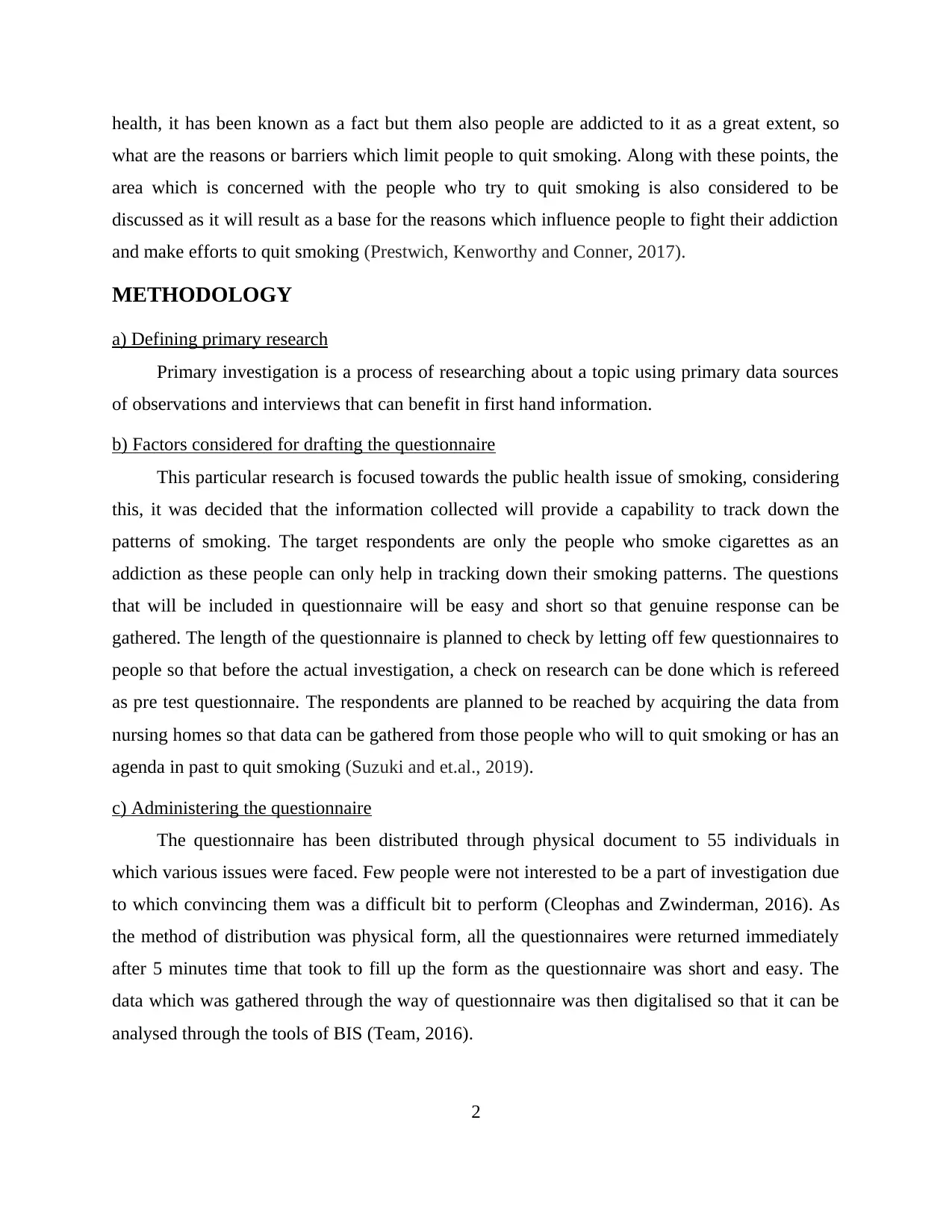
health, it has been known as a fact but them also people are addicted to it as a great extent, so
what are the reasons or barriers which limit people to quit smoking. Along with these points, the
area which is concerned with the people who try to quit smoking is also considered to be
discussed as it will result as a base for the reasons which influence people to fight their addiction
and make efforts to quit smoking (Prestwich, Kenworthy and Conner, 2017).
METHODOLOGY
a) Defining primary research
Primary investigation is a process of researching about a topic using primary data sources
of observations and interviews that can benefit in first hand information.
b) Factors considered for drafting the questionnaire
This particular research is focused towards the public health issue of smoking, considering
this, it was decided that the information collected will provide a capability to track down the
patterns of smoking. The target respondents are only the people who smoke cigarettes as an
addiction as these people can only help in tracking down their smoking patterns. The questions
that will be included in questionnaire will be easy and short so that genuine response can be
gathered. The length of the questionnaire is planned to check by letting off few questionnaires to
people so that before the actual investigation, a check on research can be done which is refereed
as pre test questionnaire. The respondents are planned to be reached by acquiring the data from
nursing homes so that data can be gathered from those people who will to quit smoking or has an
agenda in past to quit smoking (Suzuki and et.al., 2019).
c) Administering the questionnaire
The questionnaire has been distributed through physical document to 55 individuals in
which various issues were faced. Few people were not interested to be a part of investigation due
to which convincing them was a difficult bit to perform (Cleophas and Zwinderman, 2016). As
the method of distribution was physical form, all the questionnaires were returned immediately
after 5 minutes time that took to fill up the form as the questionnaire was short and easy. The
data which was gathered through the way of questionnaire was then digitalised so that it can be
analysed through the tools of BIS (Team, 2016).
2
what are the reasons or barriers which limit people to quit smoking. Along with these points, the
area which is concerned with the people who try to quit smoking is also considered to be
discussed as it will result as a base for the reasons which influence people to fight their addiction
and make efforts to quit smoking (Prestwich, Kenworthy and Conner, 2017).
METHODOLOGY
a) Defining primary research
Primary investigation is a process of researching about a topic using primary data sources
of observations and interviews that can benefit in first hand information.
b) Factors considered for drafting the questionnaire
This particular research is focused towards the public health issue of smoking, considering
this, it was decided that the information collected will provide a capability to track down the
patterns of smoking. The target respondents are only the people who smoke cigarettes as an
addiction as these people can only help in tracking down their smoking patterns. The questions
that will be included in questionnaire will be easy and short so that genuine response can be
gathered. The length of the questionnaire is planned to check by letting off few questionnaires to
people so that before the actual investigation, a check on research can be done which is refereed
as pre test questionnaire. The respondents are planned to be reached by acquiring the data from
nursing homes so that data can be gathered from those people who will to quit smoking or has an
agenda in past to quit smoking (Suzuki and et.al., 2019).
c) Administering the questionnaire
The questionnaire has been distributed through physical document to 55 individuals in
which various issues were faced. Few people were not interested to be a part of investigation due
to which convincing them was a difficult bit to perform (Cleophas and Zwinderman, 2016). As
the method of distribution was physical form, all the questionnaires were returned immediately
after 5 minutes time that took to fill up the form as the questionnaire was short and easy. The
data which was gathered through the way of questionnaire was then digitalised so that it can be
analysed through the tools of BIS (Team, 2016).
2
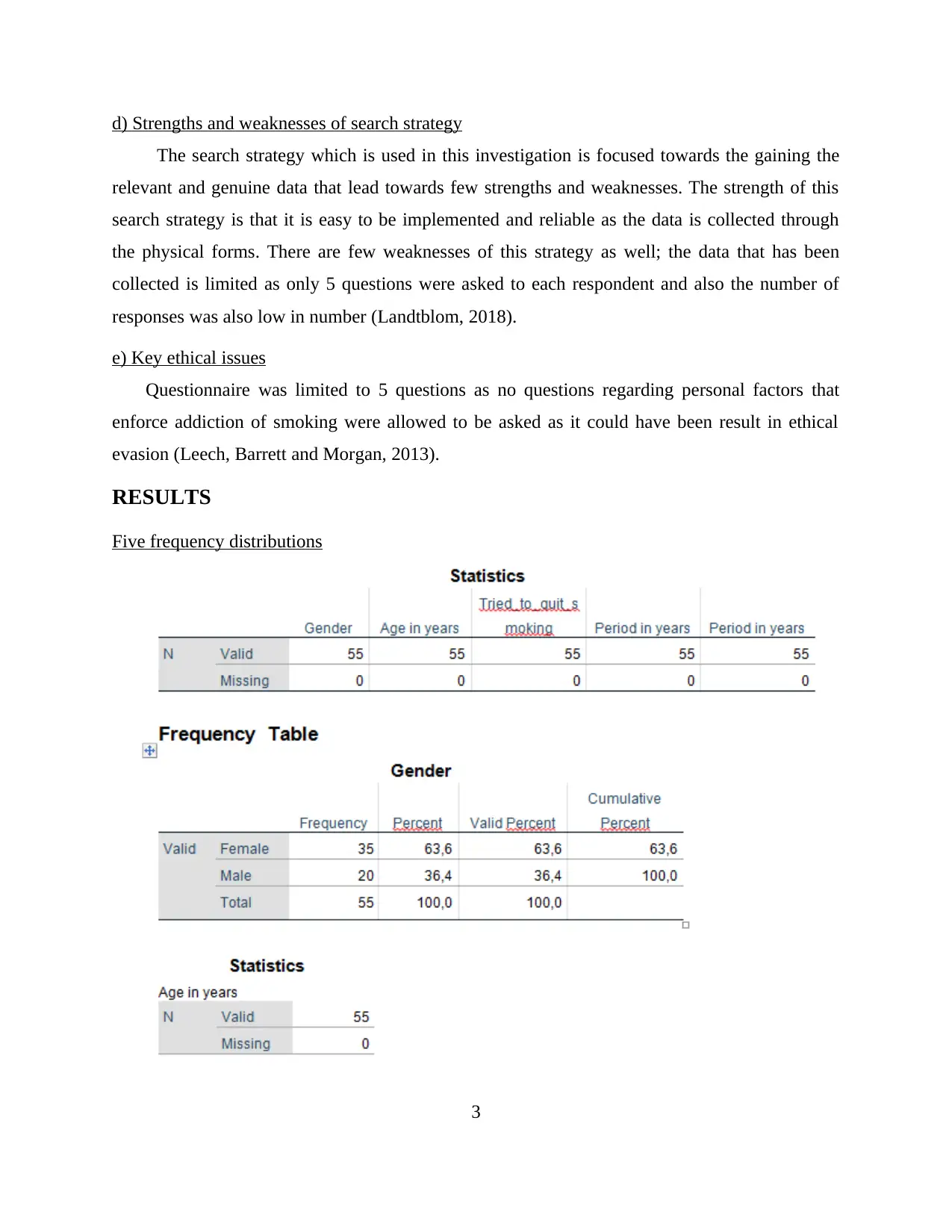
d) Strengths and weaknesses of search strategy
The search strategy which is used in this investigation is focused towards the gaining the
relevant and genuine data that lead towards few strengths and weaknesses. The strength of this
search strategy is that it is easy to be implemented and reliable as the data is collected through
the physical forms. There are few weaknesses of this strategy as well; the data that has been
collected is limited as only 5 questions were asked to each respondent and also the number of
responses was also low in number (Landtblom, 2018).
e) Key ethical issues
Questionnaire was limited to 5 questions as no questions regarding personal factors that
enforce addiction of smoking were allowed to be asked as it could have been result in ethical
evasion (Leech, Barrett and Morgan, 2013).
RESULTS
Five frequency distributions
3
The search strategy which is used in this investigation is focused towards the gaining the
relevant and genuine data that lead towards few strengths and weaknesses. The strength of this
search strategy is that it is easy to be implemented and reliable as the data is collected through
the physical forms. There are few weaknesses of this strategy as well; the data that has been
collected is limited as only 5 questions were asked to each respondent and also the number of
responses was also low in number (Landtblom, 2018).
e) Key ethical issues
Questionnaire was limited to 5 questions as no questions regarding personal factors that
enforce addiction of smoking were allowed to be asked as it could have been result in ethical
evasion (Leech, Barrett and Morgan, 2013).
RESULTS
Five frequency distributions
3
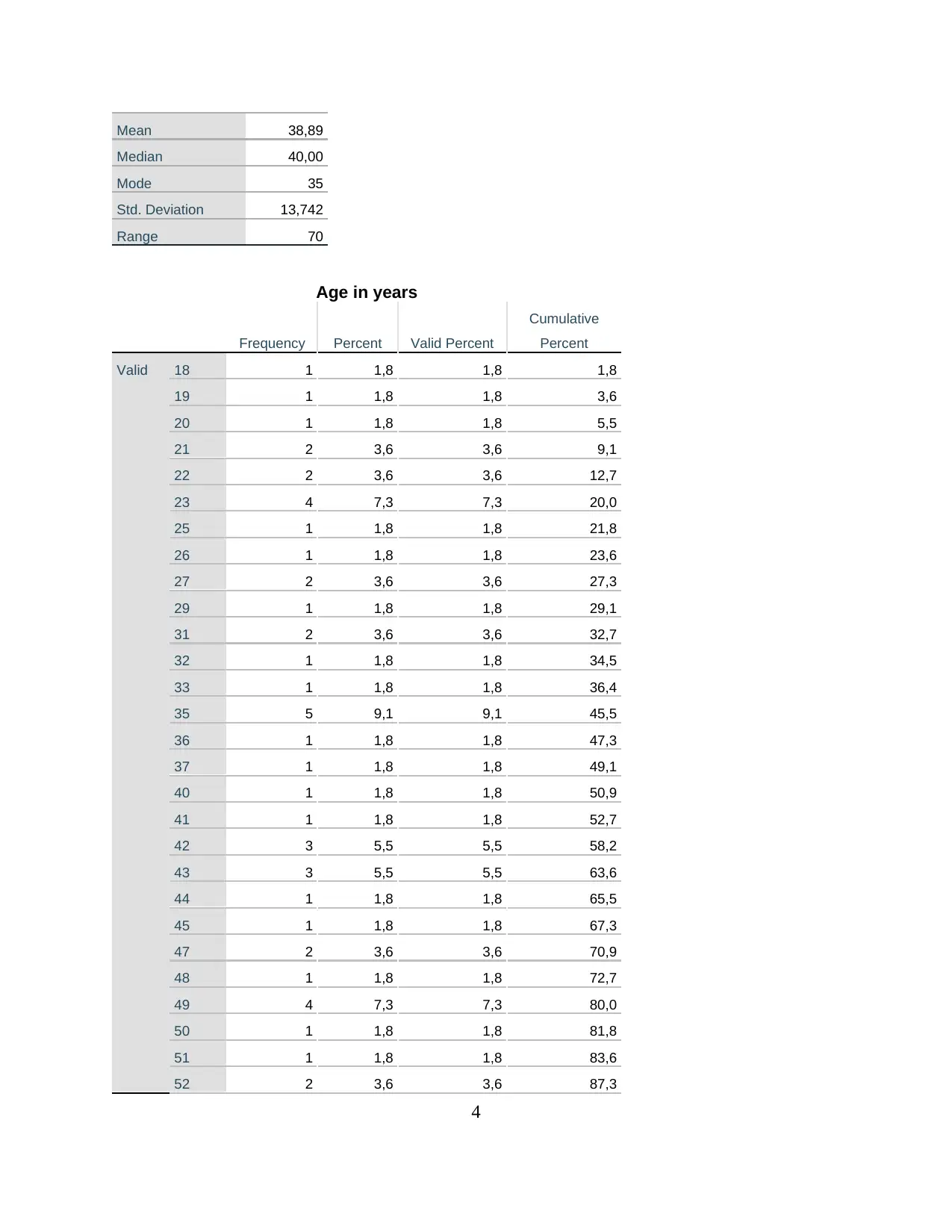
Mean 38,89
Median 40,00
Mode 35
Std. Deviation 13,742
Range 70
Age in years
Frequency Percent Valid Percent
Cumulative
Percent
Valid 18 1 1,8 1,8 1,8
19 1 1,8 1,8 3,6
20 1 1,8 1,8 5,5
21 2 3,6 3,6 9,1
22 2 3,6 3,6 12,7
23 4 7,3 7,3 20,0
25 1 1,8 1,8 21,8
26 1 1,8 1,8 23,6
27 2 3,6 3,6 27,3
29 1 1,8 1,8 29,1
31 2 3,6 3,6 32,7
32 1 1,8 1,8 34,5
33 1 1,8 1,8 36,4
35 5 9,1 9,1 45,5
36 1 1,8 1,8 47,3
37 1 1,8 1,8 49,1
40 1 1,8 1,8 50,9
41 1 1,8 1,8 52,7
42 3 5,5 5,5 58,2
43 3 5,5 5,5 63,6
44 1 1,8 1,8 65,5
45 1 1,8 1,8 67,3
47 2 3,6 3,6 70,9
48 1 1,8 1,8 72,7
49 4 7,3 7,3 80,0
50 1 1,8 1,8 81,8
51 1 1,8 1,8 83,6
52 2 3,6 3,6 87,3
4
Median 40,00
Mode 35
Std. Deviation 13,742
Range 70
Age in years
Frequency Percent Valid Percent
Cumulative
Percent
Valid 18 1 1,8 1,8 1,8
19 1 1,8 1,8 3,6
20 1 1,8 1,8 5,5
21 2 3,6 3,6 9,1
22 2 3,6 3,6 12,7
23 4 7,3 7,3 20,0
25 1 1,8 1,8 21,8
26 1 1,8 1,8 23,6
27 2 3,6 3,6 27,3
29 1 1,8 1,8 29,1
31 2 3,6 3,6 32,7
32 1 1,8 1,8 34,5
33 1 1,8 1,8 36,4
35 5 9,1 9,1 45,5
36 1 1,8 1,8 47,3
37 1 1,8 1,8 49,1
40 1 1,8 1,8 50,9
41 1 1,8 1,8 52,7
42 3 5,5 5,5 58,2
43 3 5,5 5,5 63,6
44 1 1,8 1,8 65,5
45 1 1,8 1,8 67,3
47 2 3,6 3,6 70,9
48 1 1,8 1,8 72,7
49 4 7,3 7,3 80,0
50 1 1,8 1,8 81,8
51 1 1,8 1,8 83,6
52 2 3,6 3,6 87,3
4
Paraphrase This Document
Need a fresh take? Get an instant paraphrase of this document with our AI Paraphraser
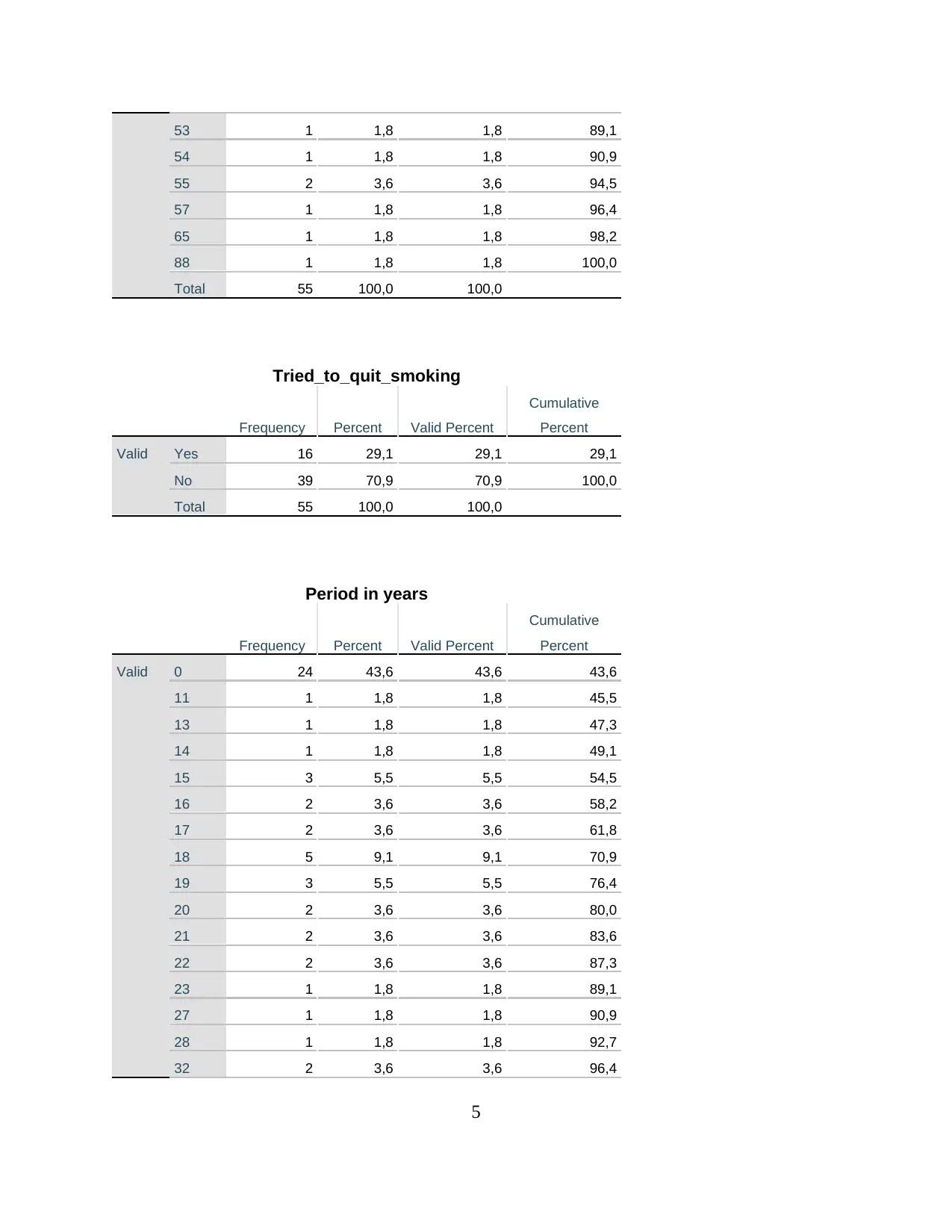
53 1 1,8 1,8 89,1
54 1 1,8 1,8 90,9
55 2 3,6 3,6 94,5
57 1 1,8 1,8 96,4
65 1 1,8 1,8 98,2
88 1 1,8 1,8 100,0
Total 55 100,0 100,0
Tried_to_quit_smoking
Frequency Percent Valid Percent
Cumulative
Percent
Valid Yes 16 29,1 29,1 29,1
No 39 70,9 70,9 100,0
Total 55 100,0 100,0
Period in years
Frequency Percent Valid Percent
Cumulative
Percent
Valid 0 24 43,6 43,6 43,6
11 1 1,8 1,8 45,5
13 1 1,8 1,8 47,3
14 1 1,8 1,8 49,1
15 3 5,5 5,5 54,5
16 2 3,6 3,6 58,2
17 2 3,6 3,6 61,8
18 5 9,1 9,1 70,9
19 3 5,5 5,5 76,4
20 2 3,6 3,6 80,0
21 2 3,6 3,6 83,6
22 2 3,6 3,6 87,3
23 1 1,8 1,8 89,1
27 1 1,8 1,8 90,9
28 1 1,8 1,8 92,7
32 2 3,6 3,6 96,4
5
54 1 1,8 1,8 90,9
55 2 3,6 3,6 94,5
57 1 1,8 1,8 96,4
65 1 1,8 1,8 98,2
88 1 1,8 1,8 100,0
Total 55 100,0 100,0
Tried_to_quit_smoking
Frequency Percent Valid Percent
Cumulative
Percent
Valid Yes 16 29,1 29,1 29,1
No 39 70,9 70,9 100,0
Total 55 100,0 100,0
Period in years
Frequency Percent Valid Percent
Cumulative
Percent
Valid 0 24 43,6 43,6 43,6
11 1 1,8 1,8 45,5
13 1 1,8 1,8 47,3
14 1 1,8 1,8 49,1
15 3 5,5 5,5 54,5
16 2 3,6 3,6 58,2
17 2 3,6 3,6 61,8
18 5 9,1 9,1 70,9
19 3 5,5 5,5 76,4
20 2 3,6 3,6 80,0
21 2 3,6 3,6 83,6
22 2 3,6 3,6 87,3
23 1 1,8 1,8 89,1
27 1 1,8 1,8 90,9
28 1 1,8 1,8 92,7
32 2 3,6 3,6 96,4
5
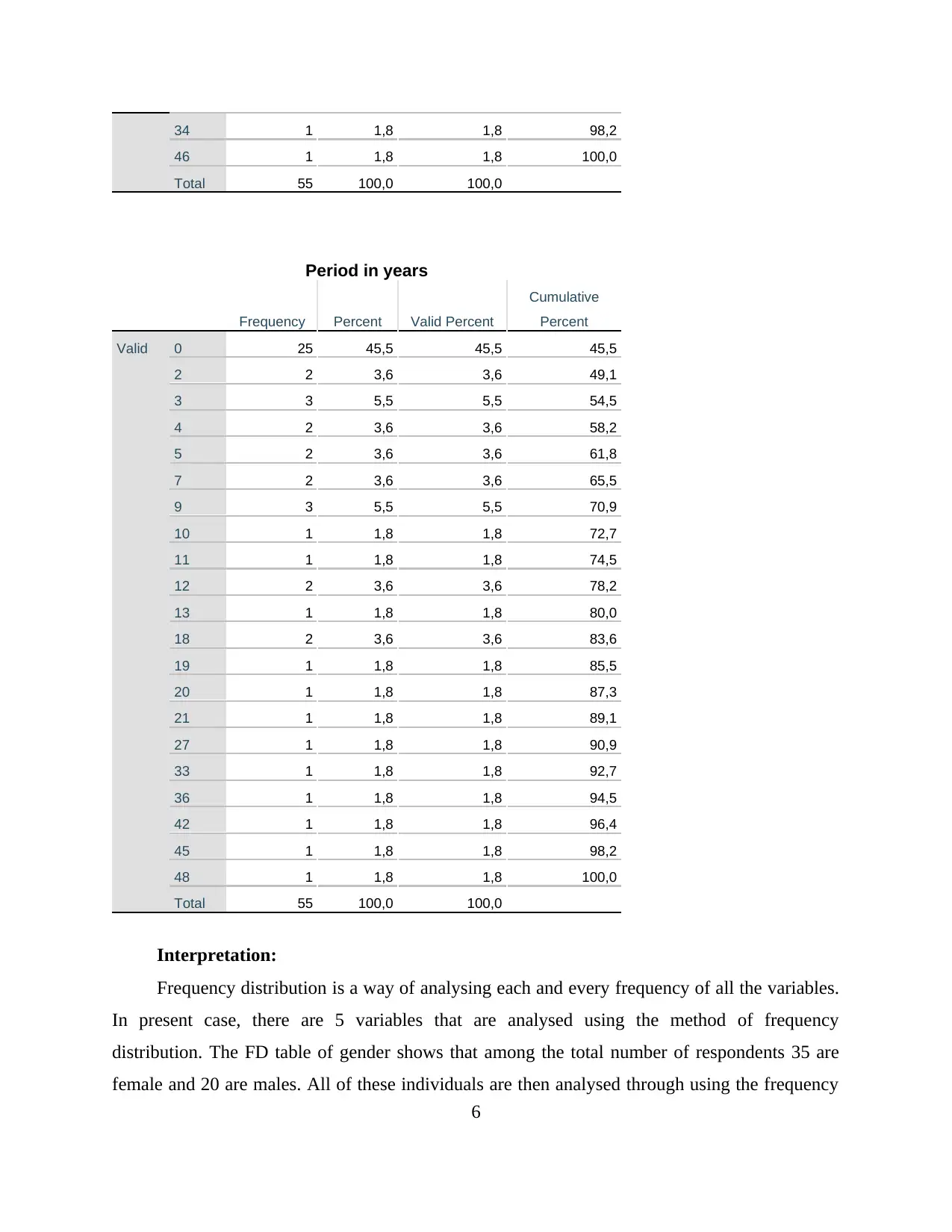
34 1 1,8 1,8 98,2
46 1 1,8 1,8 100,0
Total 55 100,0 100,0
Period in years
Frequency Percent Valid Percent
Cumulative
Percent
Valid 0 25 45,5 45,5 45,5
2 2 3,6 3,6 49,1
3 3 5,5 5,5 54,5
4 2 3,6 3,6 58,2
5 2 3,6 3,6 61,8
7 2 3,6 3,6 65,5
9 3 5,5 5,5 70,9
10 1 1,8 1,8 72,7
11 1 1,8 1,8 74,5
12 2 3,6 3,6 78,2
13 1 1,8 1,8 80,0
18 2 3,6 3,6 83,6
19 1 1,8 1,8 85,5
20 1 1,8 1,8 87,3
21 1 1,8 1,8 89,1
27 1 1,8 1,8 90,9
33 1 1,8 1,8 92,7
36 1 1,8 1,8 94,5
42 1 1,8 1,8 96,4
45 1 1,8 1,8 98,2
48 1 1,8 1,8 100,0
Total 55 100,0 100,0
Interpretation:
Frequency distribution is a way of analysing each and every frequency of all the variables.
In present case, there are 5 variables that are analysed using the method of frequency
distribution. The FD table of gender shows that among the total number of respondents 35 are
female and 20 are males. All of these individuals are then analysed through using the frequency
6
46 1 1,8 1,8 100,0
Total 55 100,0 100,0
Period in years
Frequency Percent Valid Percent
Cumulative
Percent
Valid 0 25 45,5 45,5 45,5
2 2 3,6 3,6 49,1
3 3 5,5 5,5 54,5
4 2 3,6 3,6 58,2
5 2 3,6 3,6 61,8
7 2 3,6 3,6 65,5
9 3 5,5 5,5 70,9
10 1 1,8 1,8 72,7
11 1 1,8 1,8 74,5
12 2 3,6 3,6 78,2
13 1 1,8 1,8 80,0
18 2 3,6 3,6 83,6
19 1 1,8 1,8 85,5
20 1 1,8 1,8 87,3
21 1 1,8 1,8 89,1
27 1 1,8 1,8 90,9
33 1 1,8 1,8 92,7
36 1 1,8 1,8 94,5
42 1 1,8 1,8 96,4
45 1 1,8 1,8 98,2
48 1 1,8 1,8 100,0
Total 55 100,0 100,0
Interpretation:
Frequency distribution is a way of analysing each and every frequency of all the variables.
In present case, there are 5 variables that are analysed using the method of frequency
distribution. The FD table of gender shows that among the total number of respondents 35 are
female and 20 are males. All of these individuals are then analysed through using the frequency
6
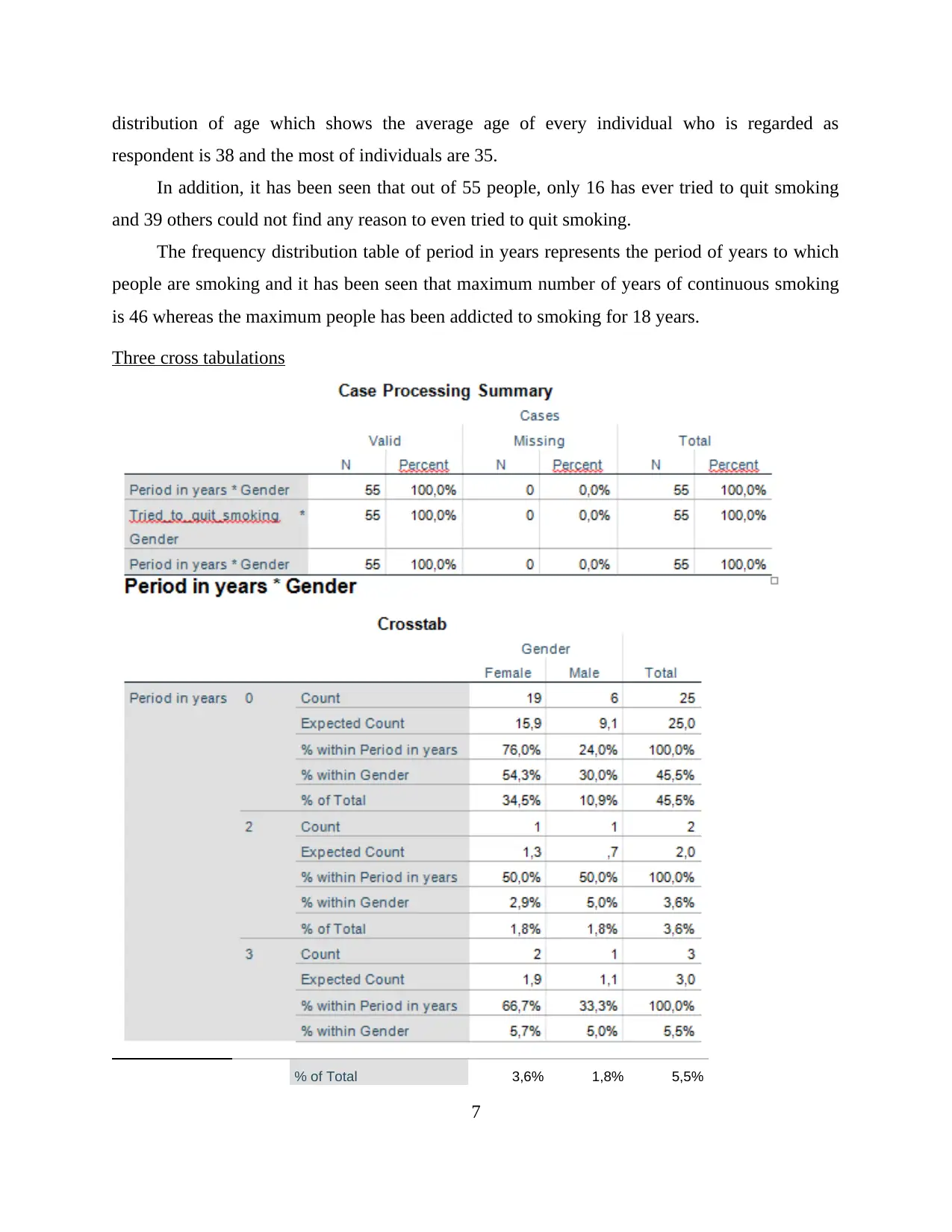
distribution of age which shows the average age of every individual who is regarded as
respondent is 38 and the most of individuals are 35.
In addition, it has been seen that out of 55 people, only 16 has ever tried to quit smoking
and 39 others could not find any reason to even tried to quit smoking.
The frequency distribution table of period in years represents the period of years to which
people are smoking and it has been seen that maximum number of years of continuous smoking
is 46 whereas the maximum people has been addicted to smoking for 18 years.
Three cross tabulations
% of Total 3,6% 1,8% 5,5%
7
respondent is 38 and the most of individuals are 35.
In addition, it has been seen that out of 55 people, only 16 has ever tried to quit smoking
and 39 others could not find any reason to even tried to quit smoking.
The frequency distribution table of period in years represents the period of years to which
people are smoking and it has been seen that maximum number of years of continuous smoking
is 46 whereas the maximum people has been addicted to smoking for 18 years.
Three cross tabulations
% of Total 3,6% 1,8% 5,5%
7
Secure Best Marks with AI Grader
Need help grading? Try our AI Grader for instant feedback on your assignments.
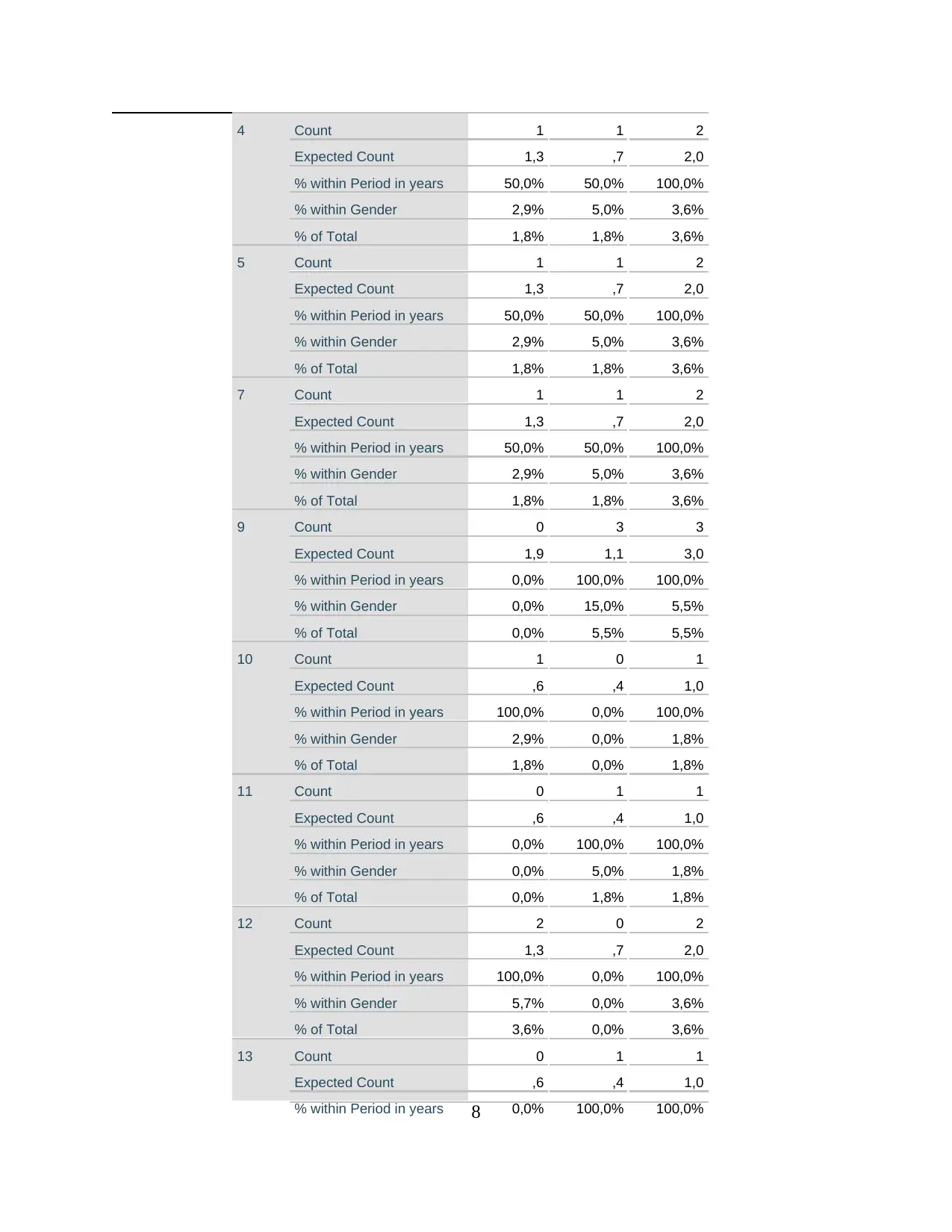
4 Count 1 1 2
Expected Count 1,3 ,7 2,0
% within Period in years 50,0% 50,0% 100,0%
% within Gender 2,9% 5,0% 3,6%
% of Total 1,8% 1,8% 3,6%
5 Count 1 1 2
Expected Count 1,3 ,7 2,0
% within Period in years 50,0% 50,0% 100,0%
% within Gender 2,9% 5,0% 3,6%
% of Total 1,8% 1,8% 3,6%
7 Count 1 1 2
Expected Count 1,3 ,7 2,0
% within Period in years 50,0% 50,0% 100,0%
% within Gender 2,9% 5,0% 3,6%
% of Total 1,8% 1,8% 3,6%
9 Count 0 3 3
Expected Count 1,9 1,1 3,0
% within Period in years 0,0% 100,0% 100,0%
% within Gender 0,0% 15,0% 5,5%
% of Total 0,0% 5,5% 5,5%
10 Count 1 0 1
Expected Count ,6 ,4 1,0
% within Period in years 100,0% 0,0% 100,0%
% within Gender 2,9% 0,0% 1,8%
% of Total 1,8% 0,0% 1,8%
11 Count 0 1 1
Expected Count ,6 ,4 1,0
% within Period in years 0,0% 100,0% 100,0%
% within Gender 0,0% 5,0% 1,8%
% of Total 0,0% 1,8% 1,8%
12 Count 2 0 2
Expected Count 1,3 ,7 2,0
% within Period in years 100,0% 0,0% 100,0%
% within Gender 5,7% 0,0% 3,6%
% of Total 3,6% 0,0% 3,6%
13 Count 0 1 1
Expected Count ,6 ,4 1,0
% within Period in years 0,0% 100,0% 100,0%8
Expected Count 1,3 ,7 2,0
% within Period in years 50,0% 50,0% 100,0%
% within Gender 2,9% 5,0% 3,6%
% of Total 1,8% 1,8% 3,6%
5 Count 1 1 2
Expected Count 1,3 ,7 2,0
% within Period in years 50,0% 50,0% 100,0%
% within Gender 2,9% 5,0% 3,6%
% of Total 1,8% 1,8% 3,6%
7 Count 1 1 2
Expected Count 1,3 ,7 2,0
% within Period in years 50,0% 50,0% 100,0%
% within Gender 2,9% 5,0% 3,6%
% of Total 1,8% 1,8% 3,6%
9 Count 0 3 3
Expected Count 1,9 1,1 3,0
% within Period in years 0,0% 100,0% 100,0%
% within Gender 0,0% 15,0% 5,5%
% of Total 0,0% 5,5% 5,5%
10 Count 1 0 1
Expected Count ,6 ,4 1,0
% within Period in years 100,0% 0,0% 100,0%
% within Gender 2,9% 0,0% 1,8%
% of Total 1,8% 0,0% 1,8%
11 Count 0 1 1
Expected Count ,6 ,4 1,0
% within Period in years 0,0% 100,0% 100,0%
% within Gender 0,0% 5,0% 1,8%
% of Total 0,0% 1,8% 1,8%
12 Count 2 0 2
Expected Count 1,3 ,7 2,0
% within Period in years 100,0% 0,0% 100,0%
% within Gender 5,7% 0,0% 3,6%
% of Total 3,6% 0,0% 3,6%
13 Count 0 1 1
Expected Count ,6 ,4 1,0
% within Period in years 0,0% 100,0% 100,0%8
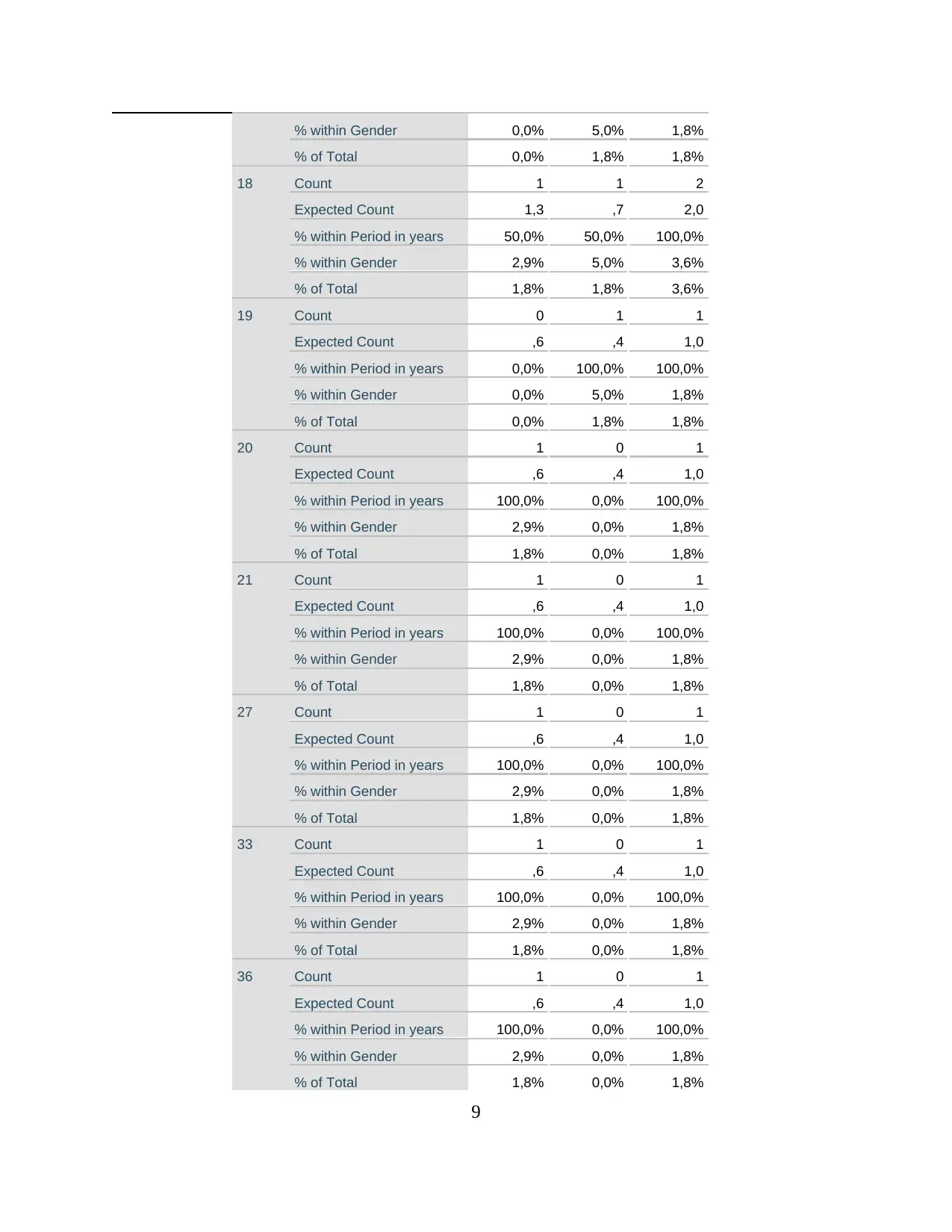
% within Gender 0,0% 5,0% 1,8%
% of Total 0,0% 1,8% 1,8%
18 Count 1 1 2
Expected Count 1,3 ,7 2,0
% within Period in years 50,0% 50,0% 100,0%
% within Gender 2,9% 5,0% 3,6%
% of Total 1,8% 1,8% 3,6%
19 Count 0 1 1
Expected Count ,6 ,4 1,0
% within Period in years 0,0% 100,0% 100,0%
% within Gender 0,0% 5,0% 1,8%
% of Total 0,0% 1,8% 1,8%
20 Count 1 0 1
Expected Count ,6 ,4 1,0
% within Period in years 100,0% 0,0% 100,0%
% within Gender 2,9% 0,0% 1,8%
% of Total 1,8% 0,0% 1,8%
21 Count 1 0 1
Expected Count ,6 ,4 1,0
% within Period in years 100,0% 0,0% 100,0%
% within Gender 2,9% 0,0% 1,8%
% of Total 1,8% 0,0% 1,8%
27 Count 1 0 1
Expected Count ,6 ,4 1,0
% within Period in years 100,0% 0,0% 100,0%
% within Gender 2,9% 0,0% 1,8%
% of Total 1,8% 0,0% 1,8%
33 Count 1 0 1
Expected Count ,6 ,4 1,0
% within Period in years 100,0% 0,0% 100,0%
% within Gender 2,9% 0,0% 1,8%
% of Total 1,8% 0,0% 1,8%
36 Count 1 0 1
Expected Count ,6 ,4 1,0
% within Period in years 100,0% 0,0% 100,0%
% within Gender 2,9% 0,0% 1,8%
% of Total 1,8% 0,0% 1,8%
9
% of Total 0,0% 1,8% 1,8%
18 Count 1 1 2
Expected Count 1,3 ,7 2,0
% within Period in years 50,0% 50,0% 100,0%
% within Gender 2,9% 5,0% 3,6%
% of Total 1,8% 1,8% 3,6%
19 Count 0 1 1
Expected Count ,6 ,4 1,0
% within Period in years 0,0% 100,0% 100,0%
% within Gender 0,0% 5,0% 1,8%
% of Total 0,0% 1,8% 1,8%
20 Count 1 0 1
Expected Count ,6 ,4 1,0
% within Period in years 100,0% 0,0% 100,0%
% within Gender 2,9% 0,0% 1,8%
% of Total 1,8% 0,0% 1,8%
21 Count 1 0 1
Expected Count ,6 ,4 1,0
% within Period in years 100,0% 0,0% 100,0%
% within Gender 2,9% 0,0% 1,8%
% of Total 1,8% 0,0% 1,8%
27 Count 1 0 1
Expected Count ,6 ,4 1,0
% within Period in years 100,0% 0,0% 100,0%
% within Gender 2,9% 0,0% 1,8%
% of Total 1,8% 0,0% 1,8%
33 Count 1 0 1
Expected Count ,6 ,4 1,0
% within Period in years 100,0% 0,0% 100,0%
% within Gender 2,9% 0,0% 1,8%
% of Total 1,8% 0,0% 1,8%
36 Count 1 0 1
Expected Count ,6 ,4 1,0
% within Period in years 100,0% 0,0% 100,0%
% within Gender 2,9% 0,0% 1,8%
% of Total 1,8% 0,0% 1,8%
9
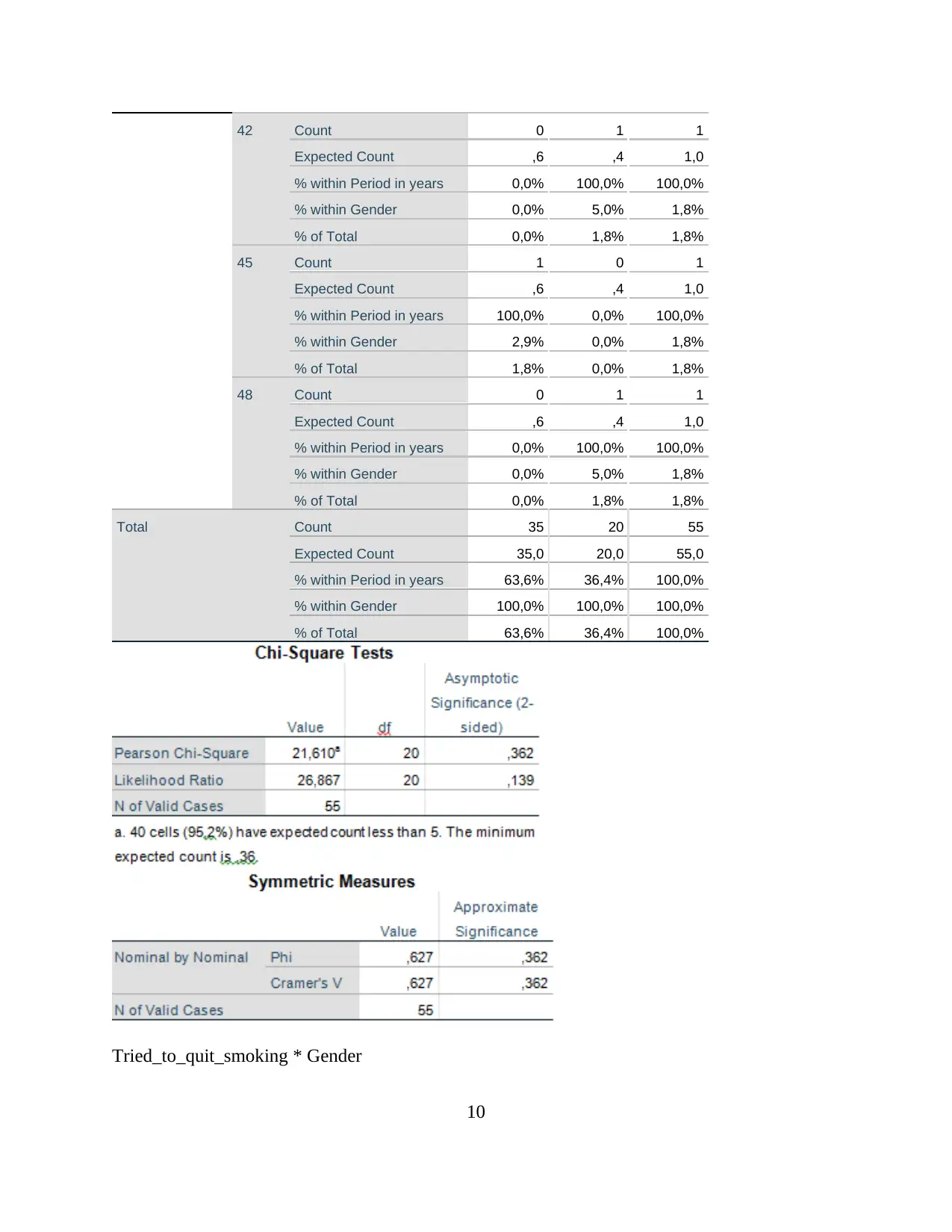
42 Count 0 1 1
Expected Count ,6 ,4 1,0
% within Period in years 0,0% 100,0% 100,0%
% within Gender 0,0% 5,0% 1,8%
% of Total 0,0% 1,8% 1,8%
45 Count 1 0 1
Expected Count ,6 ,4 1,0
% within Period in years 100,0% 0,0% 100,0%
% within Gender 2,9% 0,0% 1,8%
% of Total 1,8% 0,0% 1,8%
48 Count 0 1 1
Expected Count ,6 ,4 1,0
% within Period in years 0,0% 100,0% 100,0%
% within Gender 0,0% 5,0% 1,8%
% of Total 0,0% 1,8% 1,8%
Total Count 35 20 55
Expected Count 35,0 20,0 55,0
% within Period in years 63,6% 36,4% 100,0%
% within Gender 100,0% 100,0% 100,0%
% of Total 63,6% 36,4% 100,0%
Tried_to_quit_smoking * Gender
10
Expected Count ,6 ,4 1,0
% within Period in years 0,0% 100,0% 100,0%
% within Gender 0,0% 5,0% 1,8%
% of Total 0,0% 1,8% 1,8%
45 Count 1 0 1
Expected Count ,6 ,4 1,0
% within Period in years 100,0% 0,0% 100,0%
% within Gender 2,9% 0,0% 1,8%
% of Total 1,8% 0,0% 1,8%
48 Count 0 1 1
Expected Count ,6 ,4 1,0
% within Period in years 0,0% 100,0% 100,0%
% within Gender 0,0% 5,0% 1,8%
% of Total 0,0% 1,8% 1,8%
Total Count 35 20 55
Expected Count 35,0 20,0 55,0
% within Period in years 63,6% 36,4% 100,0%
% within Gender 100,0% 100,0% 100,0%
% of Total 63,6% 36,4% 100,0%
Tried_to_quit_smoking * Gender
10
Paraphrase This Document
Need a fresh take? Get an instant paraphrase of this document with our AI Paraphraser
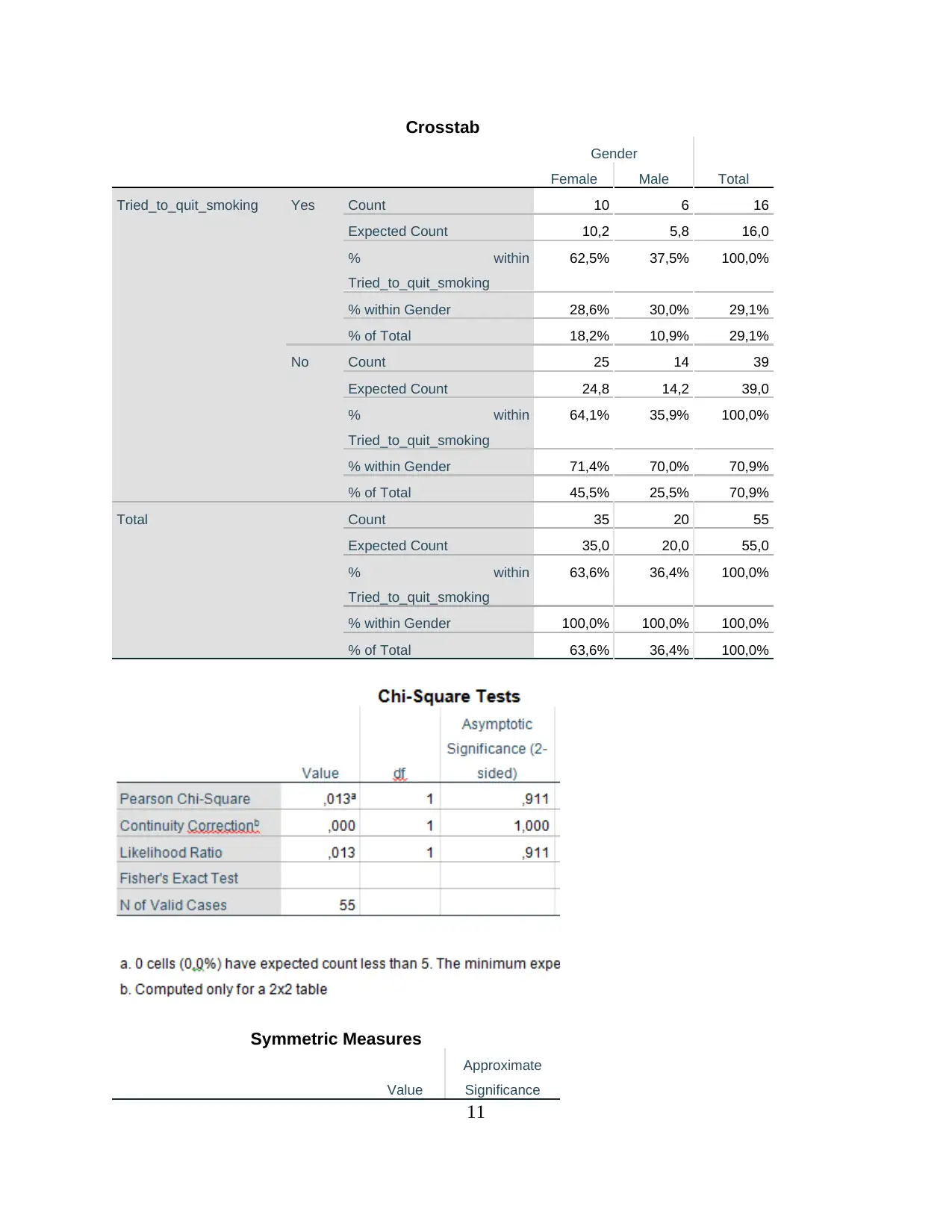
Crosstab
Gender
TotalFemale Male
Tried_to_quit_smoking Yes Count 10 6 16
Expected Count 10,2 5,8 16,0
% within
Tried_to_quit_smoking
62,5% 37,5% 100,0%
% within Gender 28,6% 30,0% 29,1%
% of Total 18,2% 10,9% 29,1%
No Count 25 14 39
Expected Count 24,8 14,2 39,0
% within
Tried_to_quit_smoking
64,1% 35,9% 100,0%
% within Gender 71,4% 70,0% 70,9%
% of Total 45,5% 25,5% 70,9%
Total Count 35 20 55
Expected Count 35,0 20,0 55,0
% within
Tried_to_quit_smoking
63,6% 36,4% 100,0%
% within Gender 100,0% 100,0% 100,0%
% of Total 63,6% 36,4% 100,0%
Symmetric Measures
Value
Approximate
Significance
11
Gender
TotalFemale Male
Tried_to_quit_smoking Yes Count 10 6 16
Expected Count 10,2 5,8 16,0
% within
Tried_to_quit_smoking
62,5% 37,5% 100,0%
% within Gender 28,6% 30,0% 29,1%
% of Total 18,2% 10,9% 29,1%
No Count 25 14 39
Expected Count 24,8 14,2 39,0
% within
Tried_to_quit_smoking
64,1% 35,9% 100,0%
% within Gender 71,4% 70,0% 70,9%
% of Total 45,5% 25,5% 70,9%
Total Count 35 20 55
Expected Count 35,0 20,0 55,0
% within
Tried_to_quit_smoking
63,6% 36,4% 100,0%
% within Gender 100,0% 100,0% 100,0%
% of Total 63,6% 36,4% 100,0%
Symmetric Measures
Value
Approximate
Significance
11
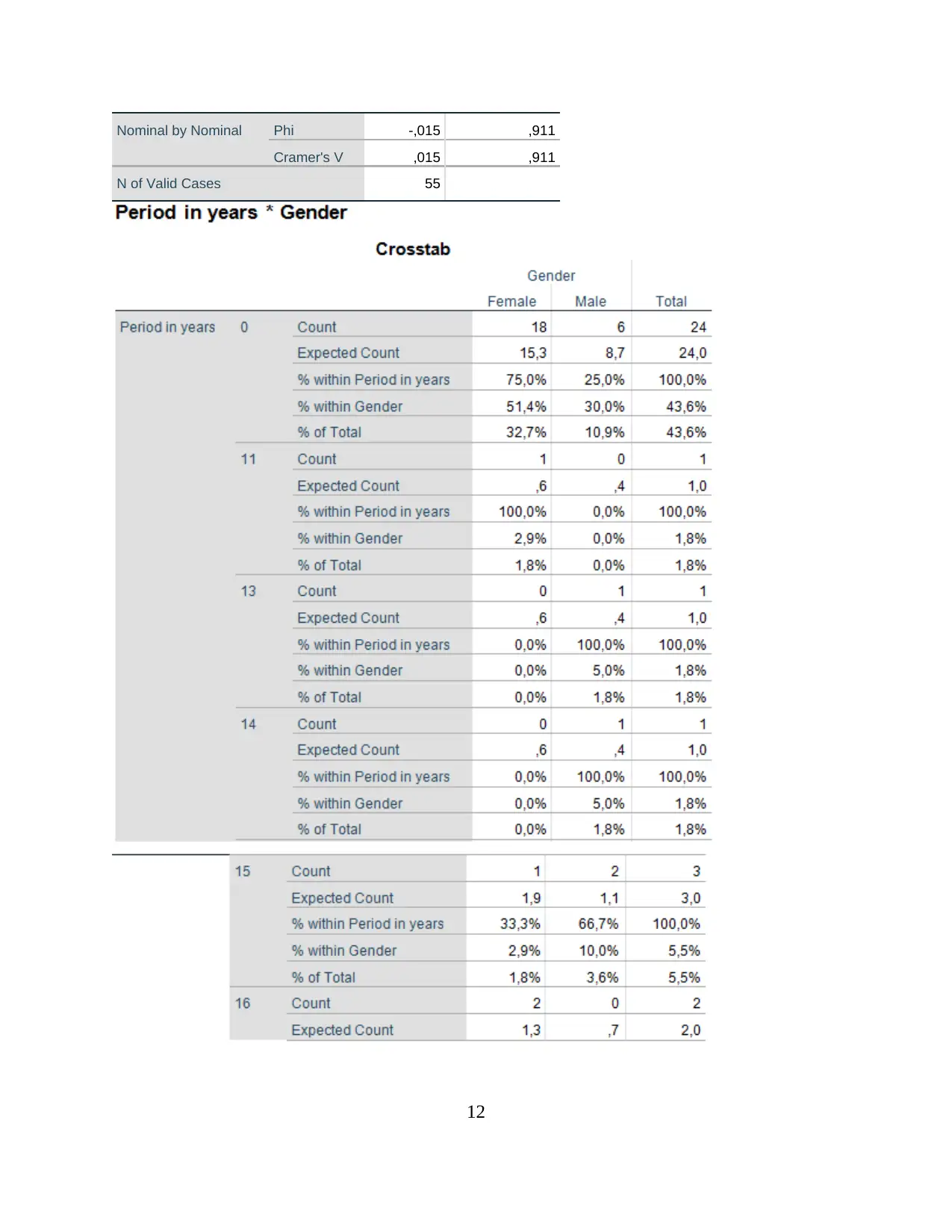
Nominal by Nominal Phi -,015 ,911
Cramer's V ,015 ,911
N of Valid Cases 55
12
Cramer's V ,015 ,911
N of Valid Cases 55
12
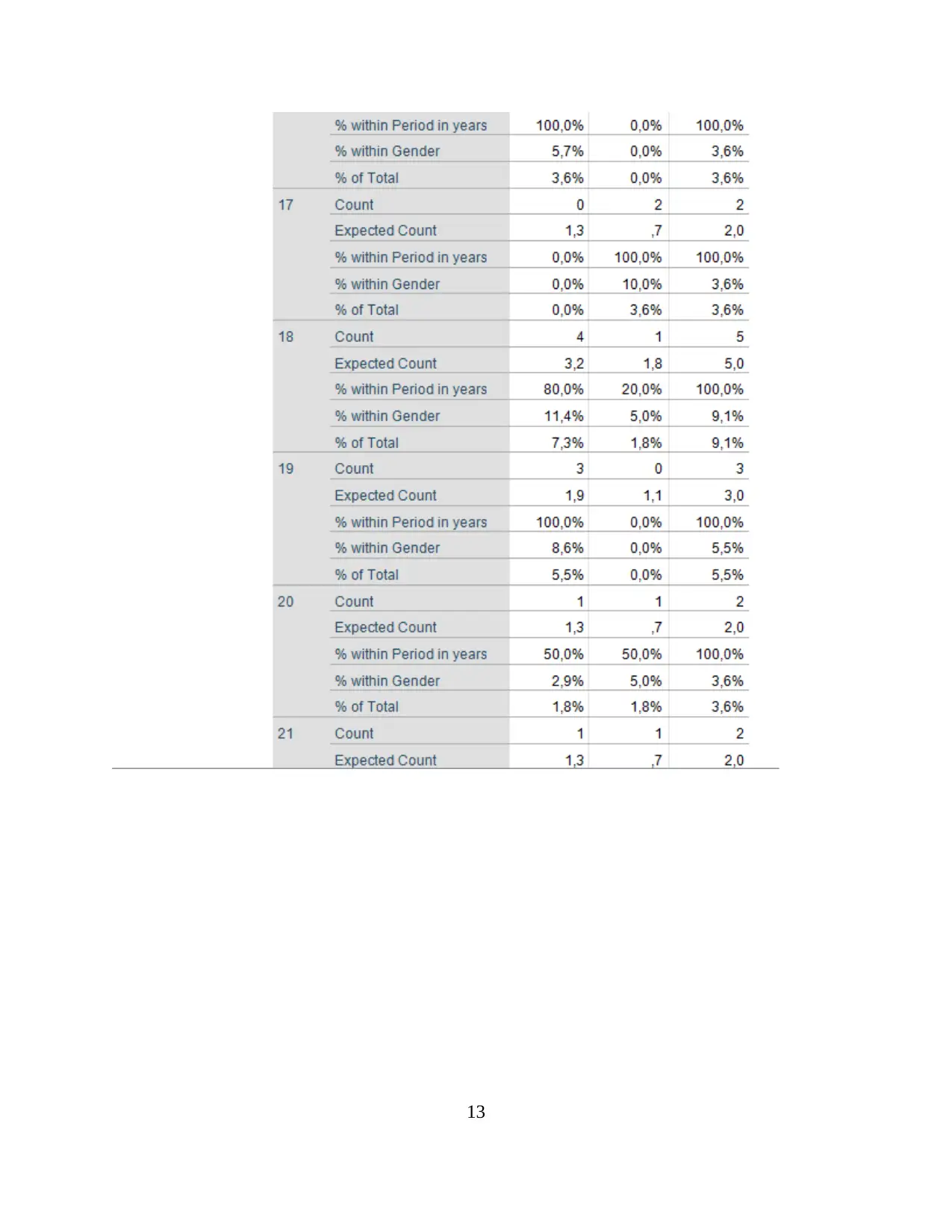
13
Secure Best Marks with AI Grader
Need help grading? Try our AI Grader for instant feedback on your assignments.
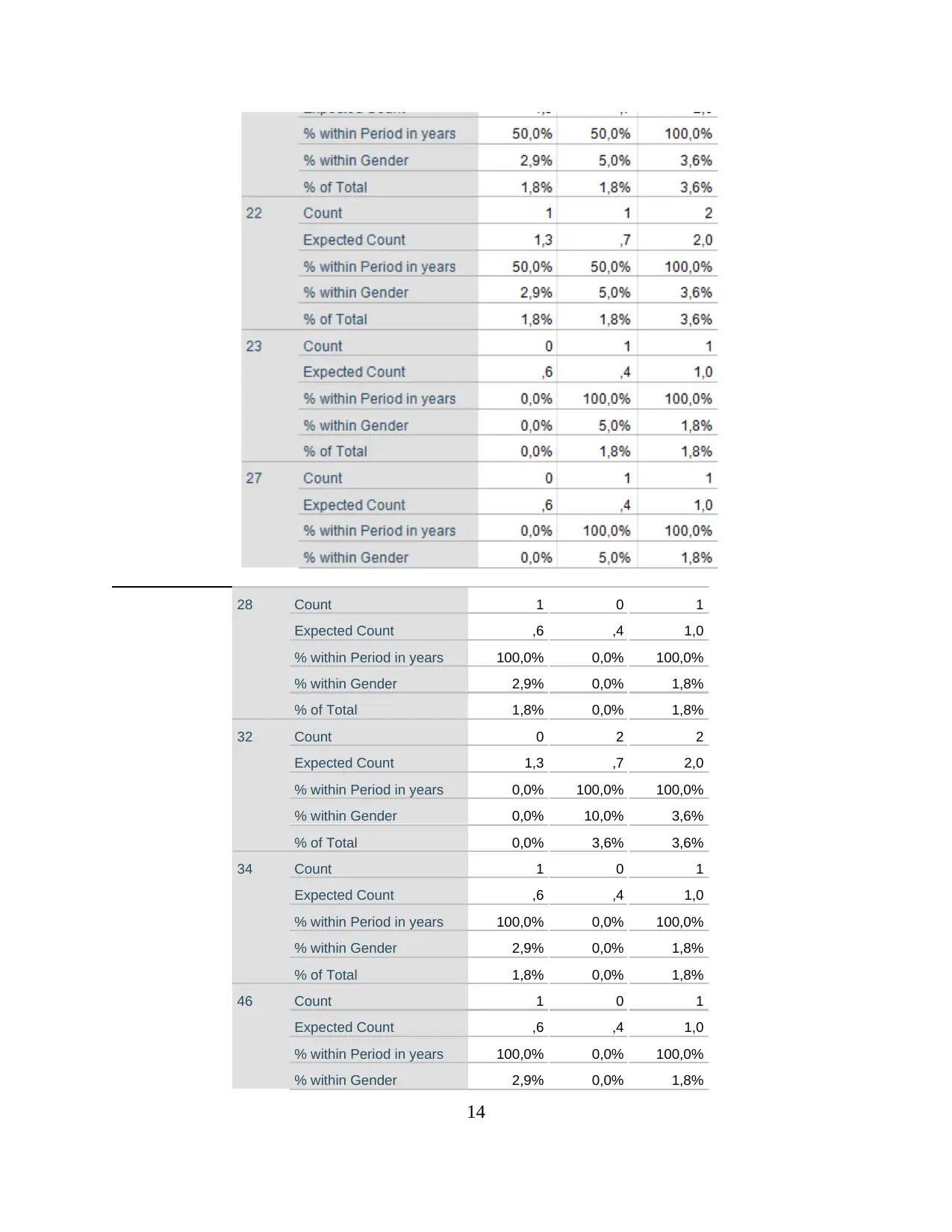
28 Count 1 0 1
Expected Count ,6 ,4 1,0
% within Period in years 100,0% 0,0% 100,0%
% within Gender 2,9% 0,0% 1,8%
% of Total 1,8% 0,0% 1,8%
32 Count 0 2 2
Expected Count 1,3 ,7 2,0
% within Period in years 0,0% 100,0% 100,0%
% within Gender 0,0% 10,0% 3,6%
% of Total 0,0% 3,6% 3,6%
34 Count 1 0 1
Expected Count ,6 ,4 1,0
% within Period in years 100,0% 0,0% 100,0%
% within Gender 2,9% 0,0% 1,8%
% of Total 1,8% 0,0% 1,8%
46 Count 1 0 1
Expected Count ,6 ,4 1,0
% within Period in years 100,0% 0,0% 100,0%
% within Gender 2,9% 0,0% 1,8%
14
Expected Count ,6 ,4 1,0
% within Period in years 100,0% 0,0% 100,0%
% within Gender 2,9% 0,0% 1,8%
% of Total 1,8% 0,0% 1,8%
32 Count 0 2 2
Expected Count 1,3 ,7 2,0
% within Period in years 0,0% 100,0% 100,0%
% within Gender 0,0% 10,0% 3,6%
% of Total 0,0% 3,6% 3,6%
34 Count 1 0 1
Expected Count ,6 ,4 1,0
% within Period in years 100,0% 0,0% 100,0%
% within Gender 2,9% 0,0% 1,8%
% of Total 1,8% 0,0% 1,8%
46 Count 1 0 1
Expected Count ,6 ,4 1,0
% within Period in years 100,0% 0,0% 100,0%
% within Gender 2,9% 0,0% 1,8%
14
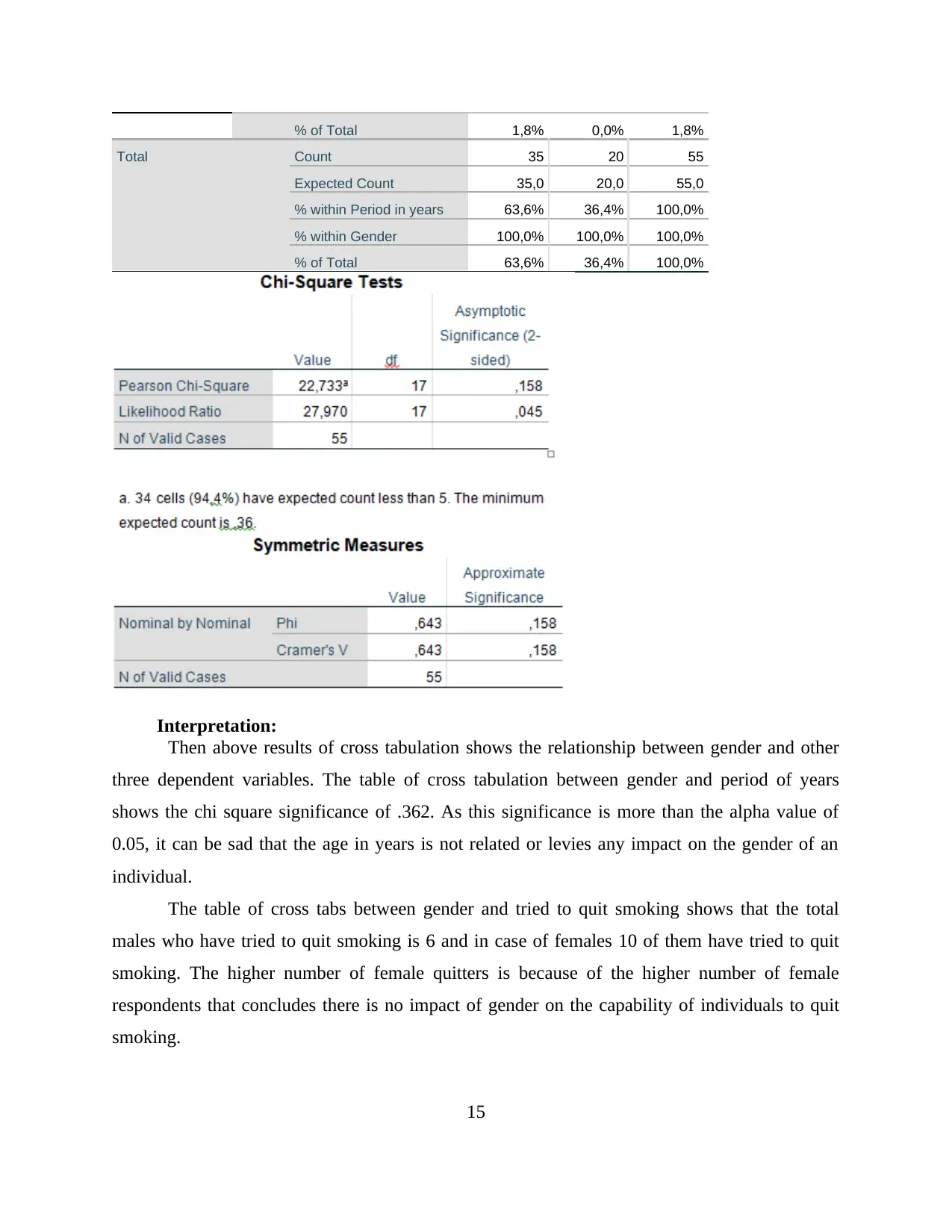
% of Total 1,8% 0,0% 1,8%
Total Count 35 20 55
Expected Count 35,0 20,0 55,0
% within Period in years 63,6% 36,4% 100,0%
% within Gender 100,0% 100,0% 100,0%
% of Total 63,6% 36,4% 100,0%
Interpretation:
Then above results of cross tabulation shows the relationship between gender and other
three dependent variables. The table of cross tabulation between gender and period of years
shows the chi square significance of .362. As this significance is more than the alpha value of
0.05, it can be sad that the age in years is not related or levies any impact on the gender of an
individual.
The table of cross tabs between gender and tried to quit smoking shows that the total
males who have tried to quit smoking is 6 and in case of females 10 of them have tried to quit
smoking. The higher number of female quitters is because of the higher number of female
respondents that concludes there is no impact of gender on the capability of individuals to quit
smoking.
15
Total Count 35 20 55
Expected Count 35,0 20,0 55,0
% within Period in years 63,6% 36,4% 100,0%
% within Gender 100,0% 100,0% 100,0%
% of Total 63,6% 36,4% 100,0%
Interpretation:
Then above results of cross tabulation shows the relationship between gender and other
three dependent variables. The table of cross tabulation between gender and period of years
shows the chi square significance of .362. As this significance is more than the alpha value of
0.05, it can be sad that the age in years is not related or levies any impact on the gender of an
individual.
The table of cross tabs between gender and tried to quit smoking shows that the total
males who have tried to quit smoking is 6 and in case of females 10 of them have tried to quit
smoking. The higher number of female quitters is because of the higher number of female
respondents that concludes there is no impact of gender on the capability of individuals to quit
smoking.
15
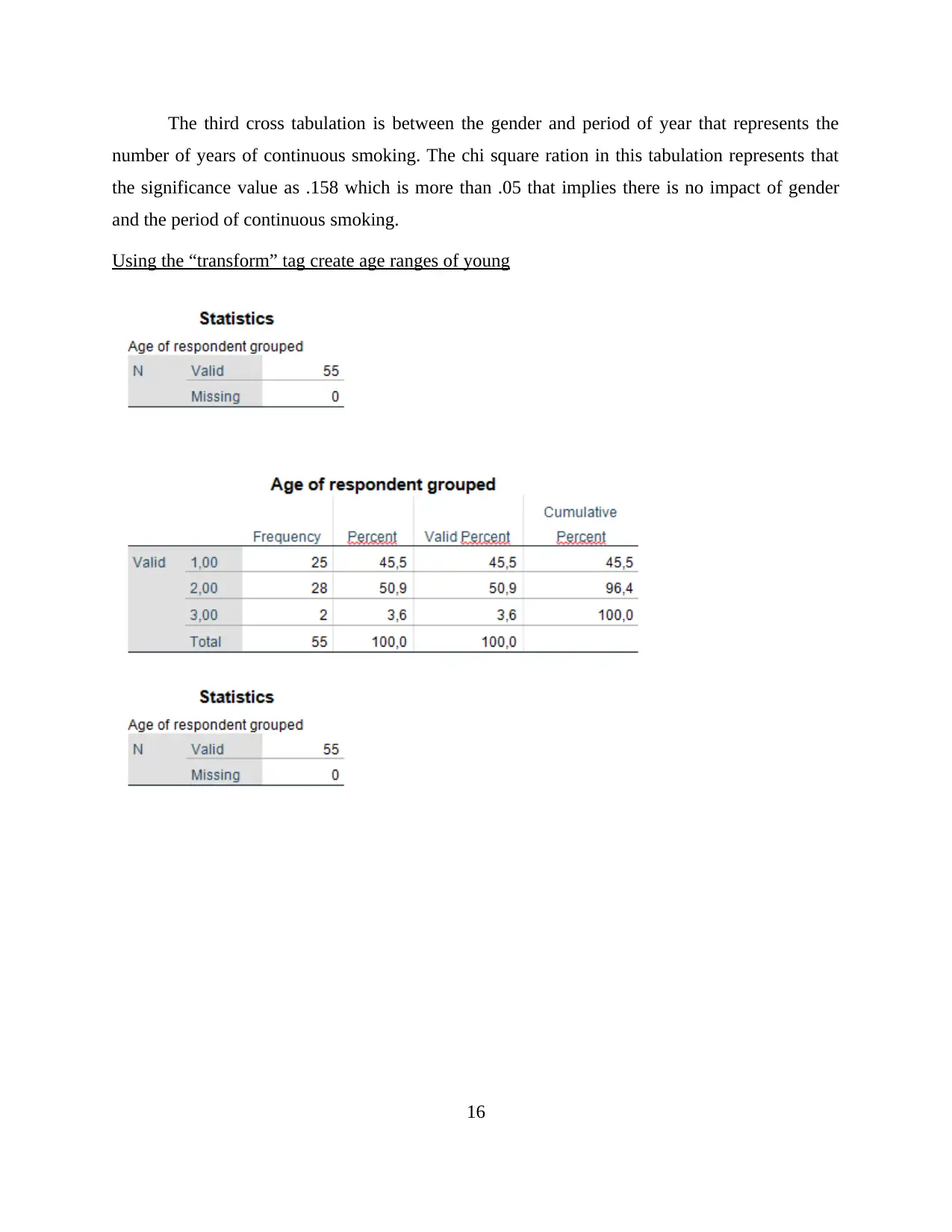
The third cross tabulation is between the gender and period of year that represents the
number of years of continuous smoking. The chi square ration in this tabulation represents that
the significance value as .158 which is more than .05 that implies there is no impact of gender
and the period of continuous smoking.
Using the “transform” tag create age ranges of young
16
number of years of continuous smoking. The chi square ration in this tabulation represents that
the significance value as .158 which is more than .05 that implies there is no impact of gender
and the period of continuous smoking.
Using the “transform” tag create age ranges of young
16
Paraphrase This Document
Need a fresh take? Get an instant paraphrase of this document with our AI Paraphraser
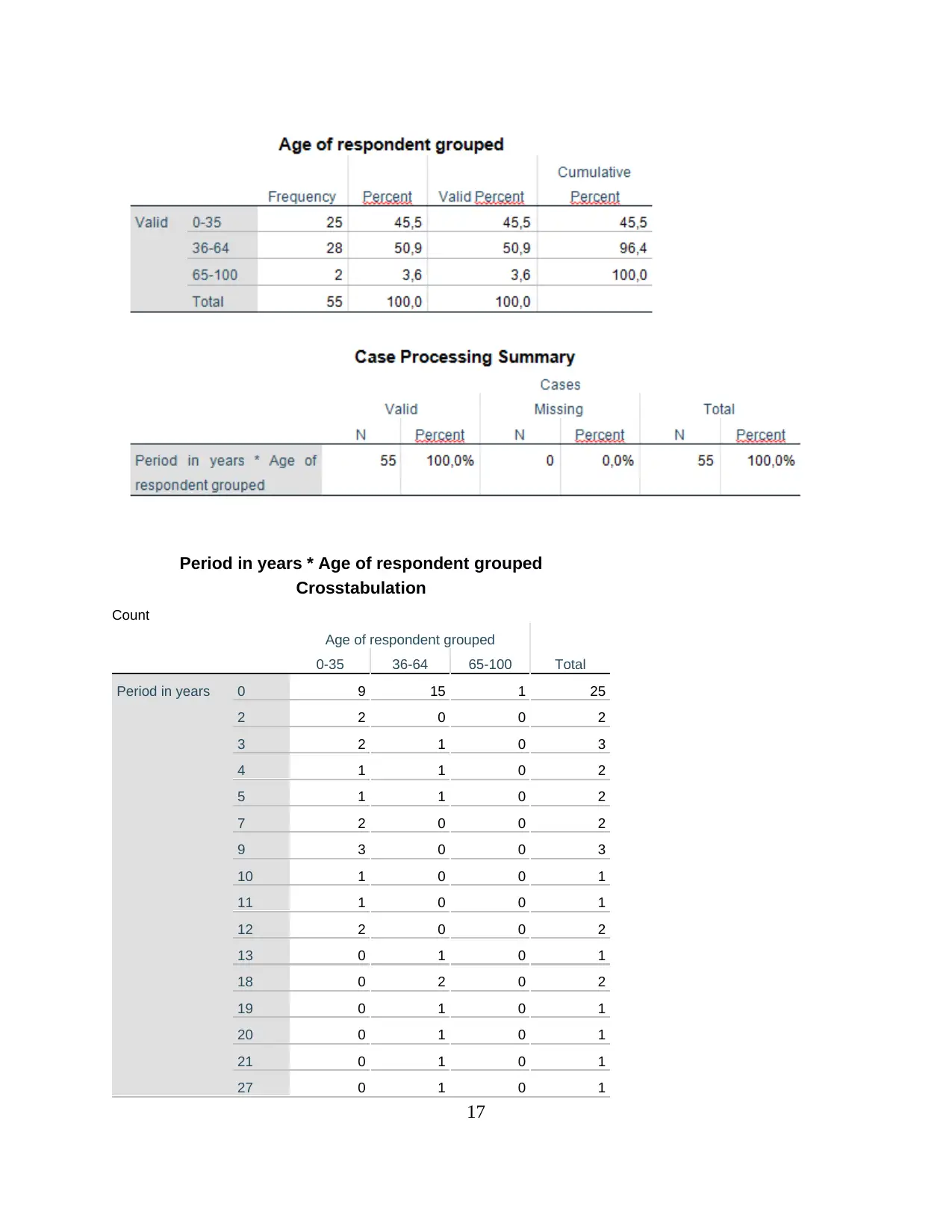
Period in years * Age of respondent grouped
Crosstabulation
Count
Age of respondent grouped
Total0-35 36-64 65-100
Period in years 0 9 15 1 25
2 2 0 0 2
3 2 1 0 3
4 1 1 0 2
5 1 1 0 2
7 2 0 0 2
9 3 0 0 3
10 1 0 0 1
11 1 0 0 1
12 2 0 0 2
13 0 1 0 1
18 0 2 0 2
19 0 1 0 1
20 0 1 0 1
21 0 1 0 1
27 0 1 0 1
17
Crosstabulation
Count
Age of respondent grouped
Total0-35 36-64 65-100
Period in years 0 9 15 1 25
2 2 0 0 2
3 2 1 0 3
4 1 1 0 2
5 1 1 0 2
7 2 0 0 2
9 3 0 0 3
10 1 0 0 1
11 1 0 0 1
12 2 0 0 2
13 0 1 0 1
18 0 2 0 2
19 0 1 0 1
20 0 1 0 1
21 0 1 0 1
27 0 1 0 1
17
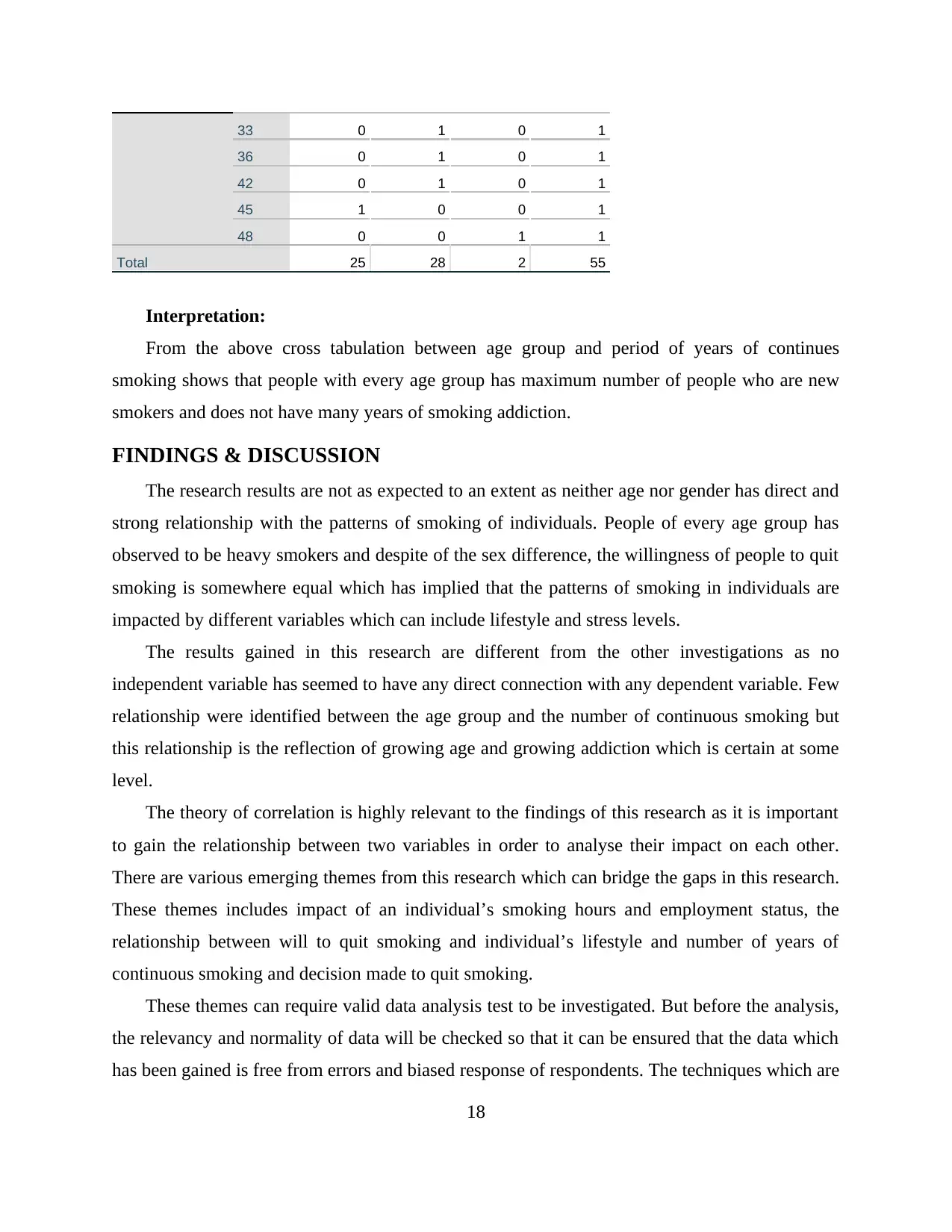
33 0 1 0 1
36 0 1 0 1
42 0 1 0 1
45 1 0 0 1
48 0 0 1 1
Total 25 28 2 55
Interpretation:
From the above cross tabulation between age group and period of years of continues
smoking shows that people with every age group has maximum number of people who are new
smokers and does not have many years of smoking addiction.
FINDINGS & DISCUSSION
The research results are not as expected to an extent as neither age nor gender has direct and
strong relationship with the patterns of smoking of individuals. People of every age group has
observed to be heavy smokers and despite of the sex difference, the willingness of people to quit
smoking is somewhere equal which has implied that the patterns of smoking in individuals are
impacted by different variables which can include lifestyle and stress levels.
The results gained in this research are different from the other investigations as no
independent variable has seemed to have any direct connection with any dependent variable. Few
relationship were identified between the age group and the number of continuous smoking but
this relationship is the reflection of growing age and growing addiction which is certain at some
level.
The theory of correlation is highly relevant to the findings of this research as it is important
to gain the relationship between two variables in order to analyse their impact on each other.
There are various emerging themes from this research which can bridge the gaps in this research.
These themes includes impact of an individual’s smoking hours and employment status, the
relationship between will to quit smoking and individual’s lifestyle and number of years of
continuous smoking and decision made to quit smoking.
These themes can require valid data analysis test to be investigated. But before the analysis,
the relevancy and normality of data will be checked so that it can be ensured that the data which
has been gained is free from errors and biased response of respondents. The techniques which are
18
36 0 1 0 1
42 0 1 0 1
45 1 0 0 1
48 0 0 1 1
Total 25 28 2 55
Interpretation:
From the above cross tabulation between age group and period of years of continues
smoking shows that people with every age group has maximum number of people who are new
smokers and does not have many years of smoking addiction.
FINDINGS & DISCUSSION
The research results are not as expected to an extent as neither age nor gender has direct and
strong relationship with the patterns of smoking of individuals. People of every age group has
observed to be heavy smokers and despite of the sex difference, the willingness of people to quit
smoking is somewhere equal which has implied that the patterns of smoking in individuals are
impacted by different variables which can include lifestyle and stress levels.
The results gained in this research are different from the other investigations as no
independent variable has seemed to have any direct connection with any dependent variable. Few
relationship were identified between the age group and the number of continuous smoking but
this relationship is the reflection of growing age and growing addiction which is certain at some
level.
The theory of correlation is highly relevant to the findings of this research as it is important
to gain the relationship between two variables in order to analyse their impact on each other.
There are various emerging themes from this research which can bridge the gaps in this research.
These themes includes impact of an individual’s smoking hours and employment status, the
relationship between will to quit smoking and individual’s lifestyle and number of years of
continuous smoking and decision made to quit smoking.
These themes can require valid data analysis test to be investigated. But before the analysis,
the relevancy and normality of data will be checked so that it can be ensured that the data which
has been gained is free from errors and biased response of respondents. The techniques which are
18
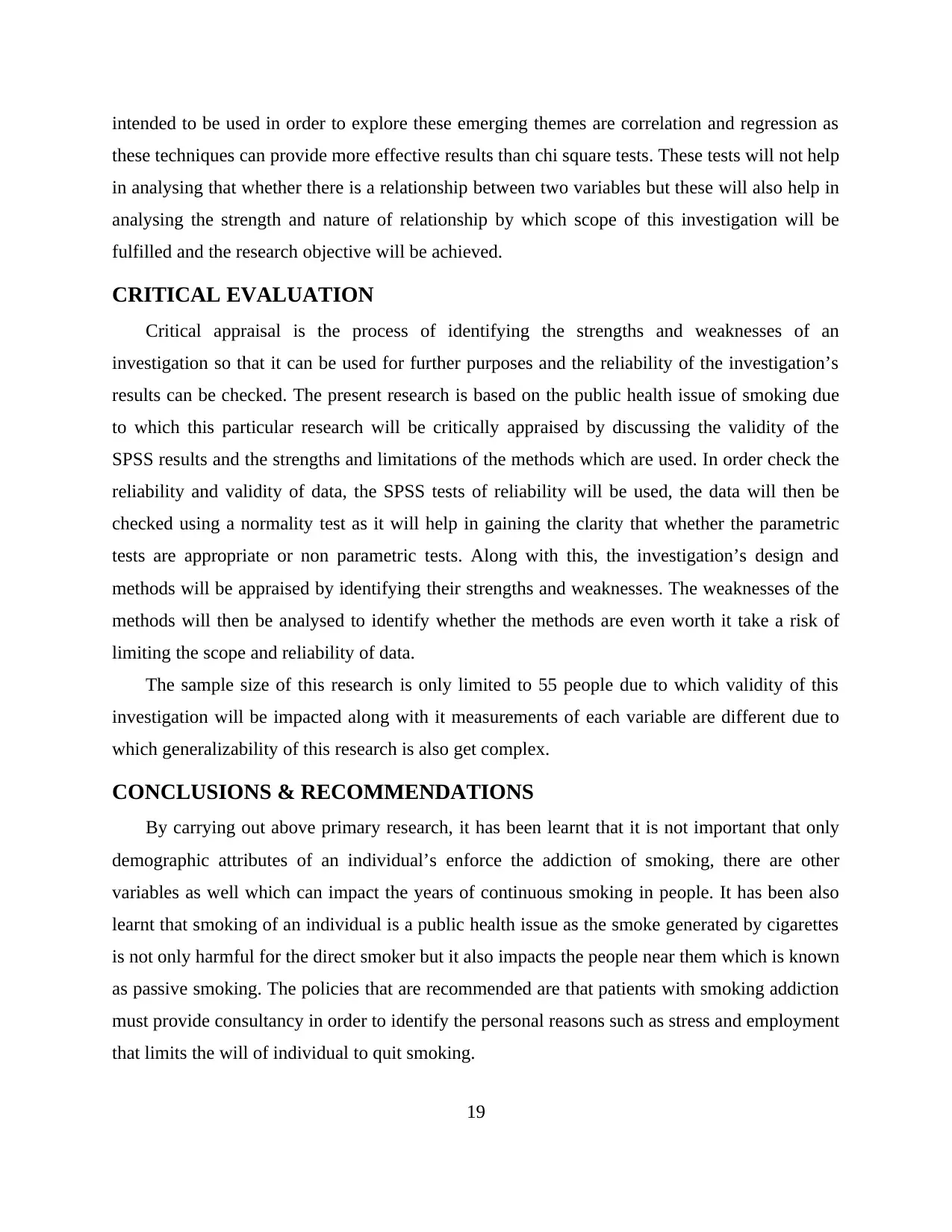
intended to be used in order to explore these emerging themes are correlation and regression as
these techniques can provide more effective results than chi square tests. These tests will not help
in analysing that whether there is a relationship between two variables but these will also help in
analysing the strength and nature of relationship by which scope of this investigation will be
fulfilled and the research objective will be achieved.
CRITICAL EVALUATION
Critical appraisal is the process of identifying the strengths and weaknesses of an
investigation so that it can be used for further purposes and the reliability of the investigation’s
results can be checked. The present research is based on the public health issue of smoking due
to which this particular research will be critically appraised by discussing the validity of the
SPSS results and the strengths and limitations of the methods which are used. In order check the
reliability and validity of data, the SPSS tests of reliability will be used, the data will then be
checked using a normality test as it will help in gaining the clarity that whether the parametric
tests are appropriate or non parametric tests. Along with this, the investigation’s design and
methods will be appraised by identifying their strengths and weaknesses. The weaknesses of the
methods will then be analysed to identify whether the methods are even worth it take a risk of
limiting the scope and reliability of data.
The sample size of this research is only limited to 55 people due to which validity of this
investigation will be impacted along with it measurements of each variable are different due to
which generalizability of this research is also get complex.
CONCLUSIONS & RECOMMENDATIONS
By carrying out above primary research, it has been learnt that it is not important that only
demographic attributes of an individual’s enforce the addiction of smoking, there are other
variables as well which can impact the years of continuous smoking in people. It has been also
learnt that smoking of an individual is a public health issue as the smoke generated by cigarettes
is not only harmful for the direct smoker but it also impacts the people near them which is known
as passive smoking. The policies that are recommended are that patients with smoking addiction
must provide consultancy in order to identify the personal reasons such as stress and employment
that limits the will of individual to quit smoking.
19
these techniques can provide more effective results than chi square tests. These tests will not help
in analysing that whether there is a relationship between two variables but these will also help in
analysing the strength and nature of relationship by which scope of this investigation will be
fulfilled and the research objective will be achieved.
CRITICAL EVALUATION
Critical appraisal is the process of identifying the strengths and weaknesses of an
investigation so that it can be used for further purposes and the reliability of the investigation’s
results can be checked. The present research is based on the public health issue of smoking due
to which this particular research will be critically appraised by discussing the validity of the
SPSS results and the strengths and limitations of the methods which are used. In order check the
reliability and validity of data, the SPSS tests of reliability will be used, the data will then be
checked using a normality test as it will help in gaining the clarity that whether the parametric
tests are appropriate or non parametric tests. Along with this, the investigation’s design and
methods will be appraised by identifying their strengths and weaknesses. The weaknesses of the
methods will then be analysed to identify whether the methods are even worth it take a risk of
limiting the scope and reliability of data.
The sample size of this research is only limited to 55 people due to which validity of this
investigation will be impacted along with it measurements of each variable are different due to
which generalizability of this research is also get complex.
CONCLUSIONS & RECOMMENDATIONS
By carrying out above primary research, it has been learnt that it is not important that only
demographic attributes of an individual’s enforce the addiction of smoking, there are other
variables as well which can impact the years of continuous smoking in people. It has been also
learnt that smoking of an individual is a public health issue as the smoke generated by cigarettes
is not only harmful for the direct smoker but it also impacts the people near them which is known
as passive smoking. The policies that are recommended are that patients with smoking addiction
must provide consultancy in order to identify the personal reasons such as stress and employment
that limits the will of individual to quit smoking.
19
Secure Best Marks with AI Grader
Need help grading? Try our AI Grader for instant feedback on your assignments.
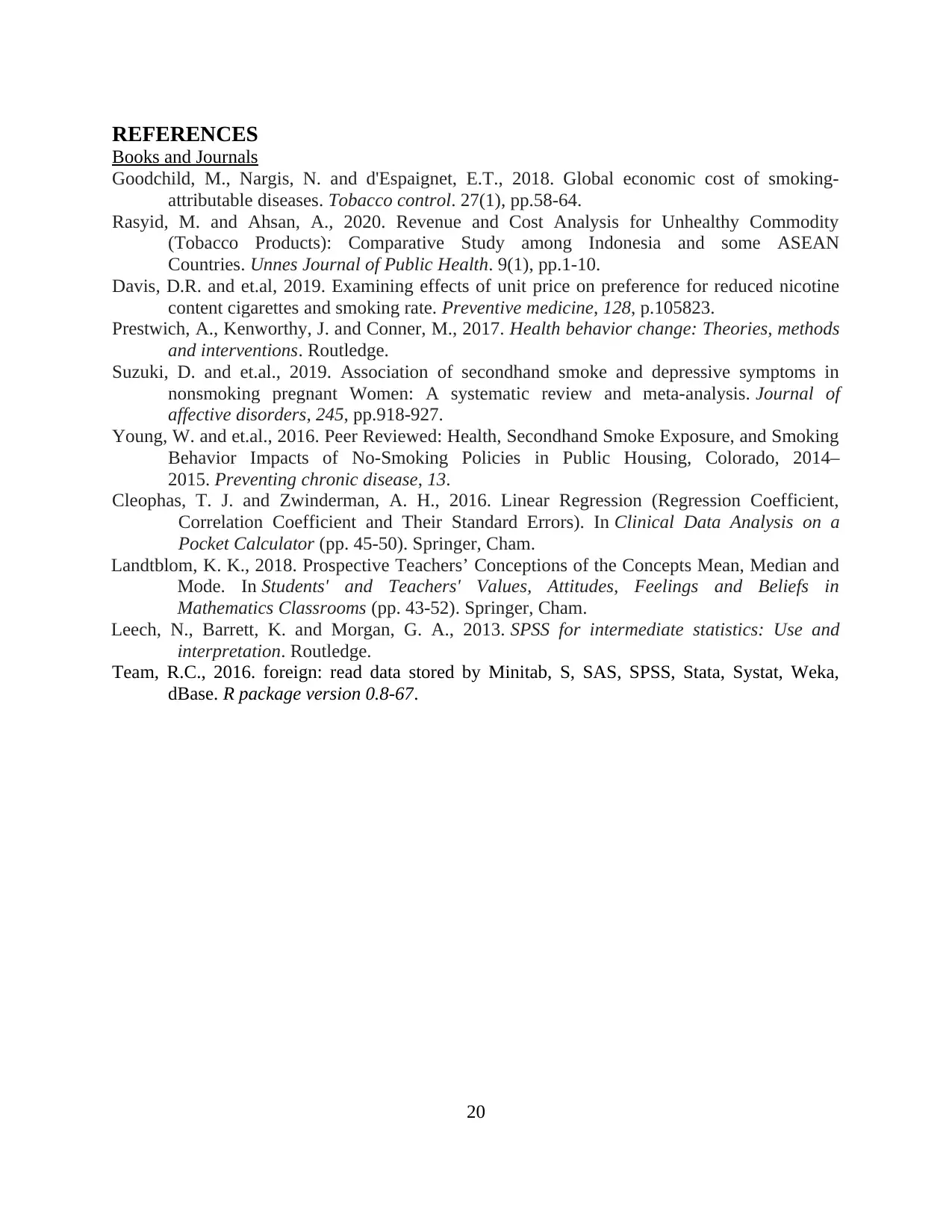
REFERENCES
Books and Journals
Goodchild, M., Nargis, N. and d'Espaignet, E.T., 2018. Global economic cost of smoking-
attributable diseases. Tobacco control. 27(1), pp.58-64.
Rasyid, M. and Ahsan, A., 2020. Revenue and Cost Analysis for Unhealthy Commodity
(Tobacco Products): Comparative Study among Indonesia and some ASEAN
Countries. Unnes Journal of Public Health. 9(1), pp.1-10.
Davis, D.R. and et.al, 2019. Examining effects of unit price on preference for reduced nicotine
content cigarettes and smoking rate. Preventive medicine, 128, p.105823.
Prestwich, A., Kenworthy, J. and Conner, M., 2017. Health behavior change: Theories, methods
and interventions. Routledge.
Suzuki, D. and et.al., 2019. Association of secondhand smoke and depressive symptoms in
nonsmoking pregnant Women: A systematic review and meta-analysis. Journal of
affective disorders, 245, pp.918-927.
Young, W. and et.al., 2016. Peer Reviewed: Health, Secondhand Smoke Exposure, and Smoking
Behavior Impacts of No-Smoking Policies in Public Housing, Colorado, 2014–
2015. Preventing chronic disease, 13.
Cleophas, T. J. and Zwinderman, A. H., 2016. Linear Regression (Regression Coefficient,
Correlation Coefficient and Their Standard Errors). In Clinical Data Analysis on a
Pocket Calculator (pp. 45-50). Springer, Cham.
Landtblom, K. K., 2018. Prospective Teachers’ Conceptions of the Concepts Mean, Median and
Mode. In Students' and Teachers' Values, Attitudes, Feelings and Beliefs in
Mathematics Classrooms (pp. 43-52). Springer, Cham.
Leech, N., Barrett, K. and Morgan, G. A., 2013. SPSS for intermediate statistics: Use and
interpretation. Routledge.
Team, R.C., 2016. foreign: read data stored by Minitab, S, SAS, SPSS, Stata, Systat, Weka,
dBase. R package version 0.8-67.
20
Books and Journals
Goodchild, M., Nargis, N. and d'Espaignet, E.T., 2018. Global economic cost of smoking-
attributable diseases. Tobacco control. 27(1), pp.58-64.
Rasyid, M. and Ahsan, A., 2020. Revenue and Cost Analysis for Unhealthy Commodity
(Tobacco Products): Comparative Study among Indonesia and some ASEAN
Countries. Unnes Journal of Public Health. 9(1), pp.1-10.
Davis, D.R. and et.al, 2019. Examining effects of unit price on preference for reduced nicotine
content cigarettes and smoking rate. Preventive medicine, 128, p.105823.
Prestwich, A., Kenworthy, J. and Conner, M., 2017. Health behavior change: Theories, methods
and interventions. Routledge.
Suzuki, D. and et.al., 2019. Association of secondhand smoke and depressive symptoms in
nonsmoking pregnant Women: A systematic review and meta-analysis. Journal of
affective disorders, 245, pp.918-927.
Young, W. and et.al., 2016. Peer Reviewed: Health, Secondhand Smoke Exposure, and Smoking
Behavior Impacts of No-Smoking Policies in Public Housing, Colorado, 2014–
2015. Preventing chronic disease, 13.
Cleophas, T. J. and Zwinderman, A. H., 2016. Linear Regression (Regression Coefficient,
Correlation Coefficient and Their Standard Errors). In Clinical Data Analysis on a
Pocket Calculator (pp. 45-50). Springer, Cham.
Landtblom, K. K., 2018. Prospective Teachers’ Conceptions of the Concepts Mean, Median and
Mode. In Students' and Teachers' Values, Attitudes, Feelings and Beliefs in
Mathematics Classrooms (pp. 43-52). Springer, Cham.
Leech, N., Barrett, K. and Morgan, G. A., 2013. SPSS for intermediate statistics: Use and
interpretation. Routledge.
Team, R.C., 2016. foreign: read data stored by Minitab, S, SAS, SPSS, Stata, Systat, Weka,
dBase. R package version 0.8-67.
20
1 out of 23
Related Documents
Your All-in-One AI-Powered Toolkit for Academic Success.
+13062052269
info@desklib.com
Available 24*7 on WhatsApp / Email
![[object Object]](/_next/static/media/star-bottom.7253800d.svg)
Unlock your academic potential
© 2024 | Zucol Services PVT LTD | All rights reserved.





